Sercomm RC8061 Wireless Network Camera User Manual
Sercomm Corporation Wireless Network Camera
Sercomm >
Contents
- 1. User manual 1
- 2. User manual 2
User manual 2

48
White Light LEDs If the checkbox is enabled, the white light LEDs will be turned on
when the surrounding light is below 0.5 lux and Trigger Event
option in the event trigger screen is enabled.
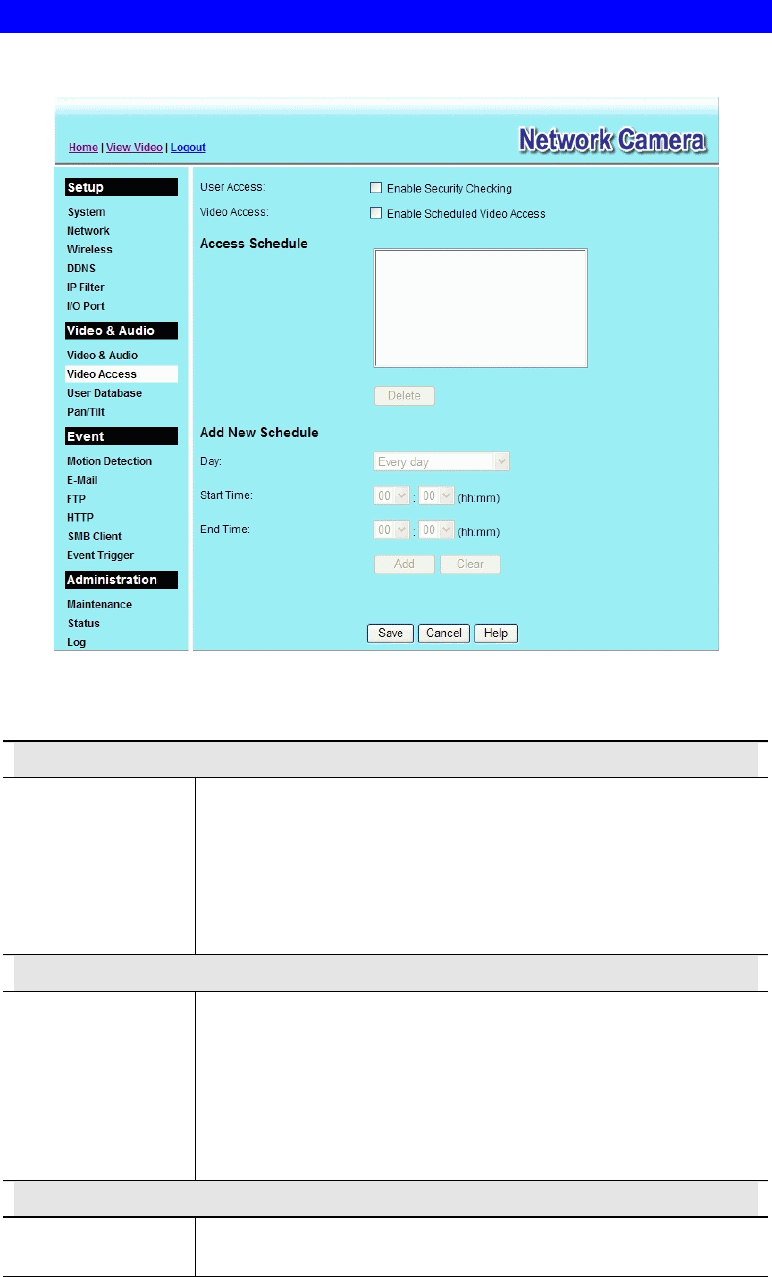
49
Video Access Screen
This screen is displayed when the Video Access option on the Video & Audio menu is clicked.
Figure 34: Video Access Screen
Data - Video Access Screen
User Access
Enable Security
Checking
• If disabled (default) - No login required. Users do not have to
provide a username and password when they connect to the
camera for viewing video.
• If enabled - Require login. Users will be prompted for a
username and password when they connect to the camera for
viewing video. The camera administrator must use the "User
Database" menu option to create the desired users.
Video Access
Enable Scheduled
Video Access
• If enabled - Viewing video is available during the scheduled
periods, and unavailable at other times. If this option is selected,
you need to define a schedule. If no schedule is defined, this
option is always disabled.
• If disabled - The option will remain disabled until you enable it.
Note that regardless of which setting is chosen, the Administrator
can ALWAYS access the camera and view live video.
Access Schedule
Scheduled Periods This displays all periods you have entered into the database. If you
have not entered any periods, this list will be empty.
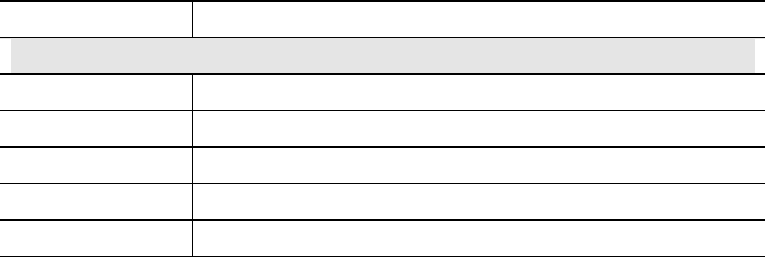
50
Delete Use the Delete button to delete the selected item in the list.
Add New Schedule
Day Choose the desired option for the period.
Start Time Enter the start time using a 24 hr clock.
End Time Enter the end time using a 24 hr clock.
Add Click this button to add a new period.
Clear Use this button to clear the input fields.
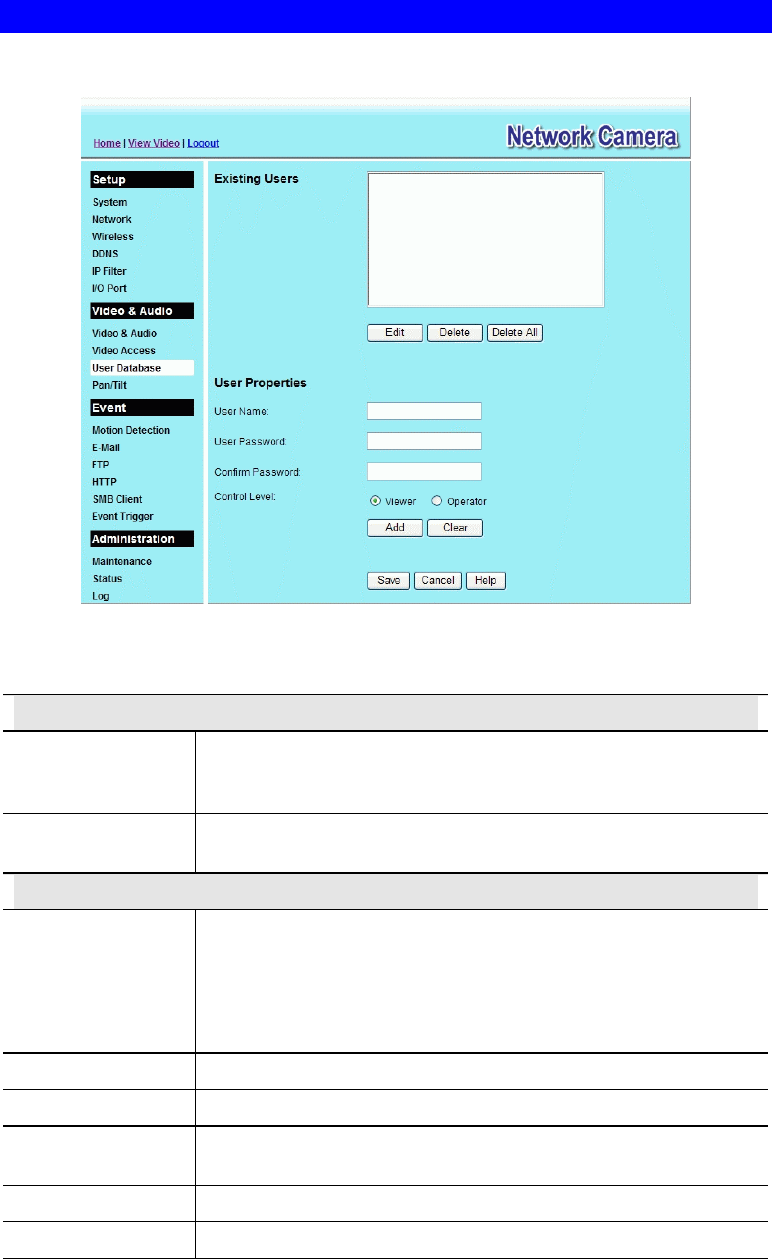
51
User Database Screen
This screen is displayed when the User Database option is clicked.
Figure 35: User Database Screen
Data - User Database Screen
Existing Users
User List This displays all users you have entered into the User database. If
you have not entered any users, this list will be empty.
The maximum number of users is 20.
Edit, Delete, Delete
All Use these buttons to manage the user database.
User Properties
User Name Enter the name for the user here.
• Spaces, punctuation, and special characters must NOT be used
in the name.
• The name is case insensitive (case is ignored), so you can not
have 2 names which differ only by case.
User Password The password for this user.
Confirm Password Re-enter the password for the user, to ensure it is correct.
Control Level Select either Viewer or Operator for the user you plan to add.
(Operator level allows user to control Pan/Tilt)
Add Button Click this button to add a new user, using the data shown on screen.
Clear Button Use this button to clear the input fields, ready to add a new user.
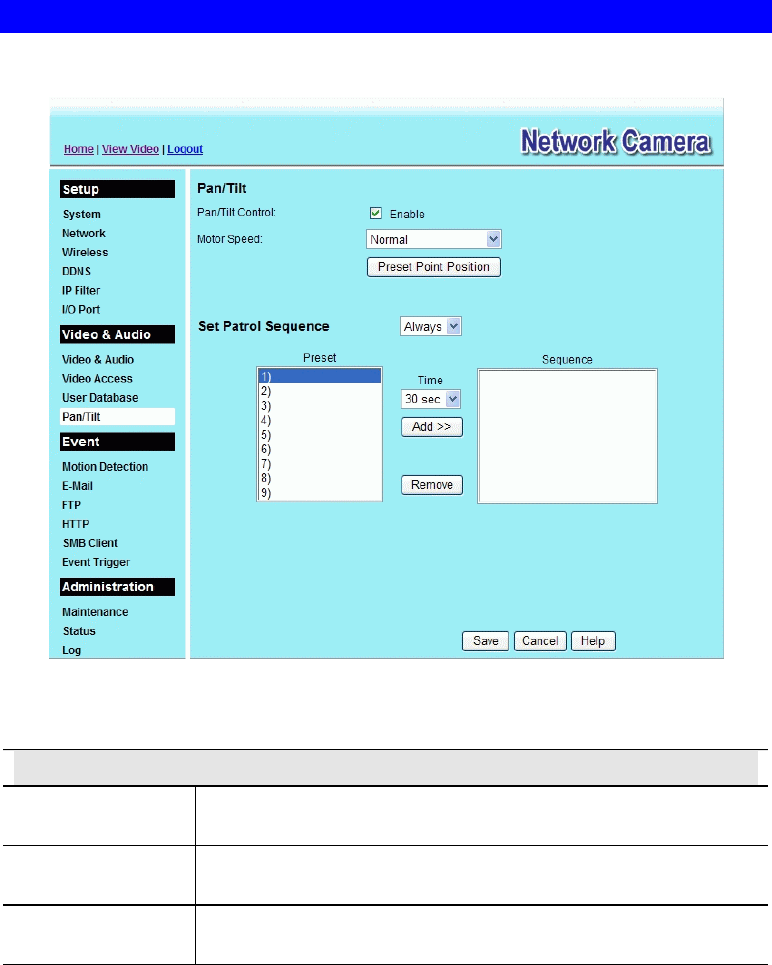
52
Pan/Tilt Screen
This screen is displayed when the Pan/Tilt option on the Video & Audio menu is clicked.
Figure 36: Pan/Tilt Screen
Data - Pan/Tilt Screen
Pan/Tilt
Enable Pan/Tilt
Control Enable the checkbox in order to use the Pan/Tilt function.
Motor Speed Select the desired motor speed for the Pan/Tilt control. The default
value is Normal.
Preset Point
Position Click this button to define the preset point position.
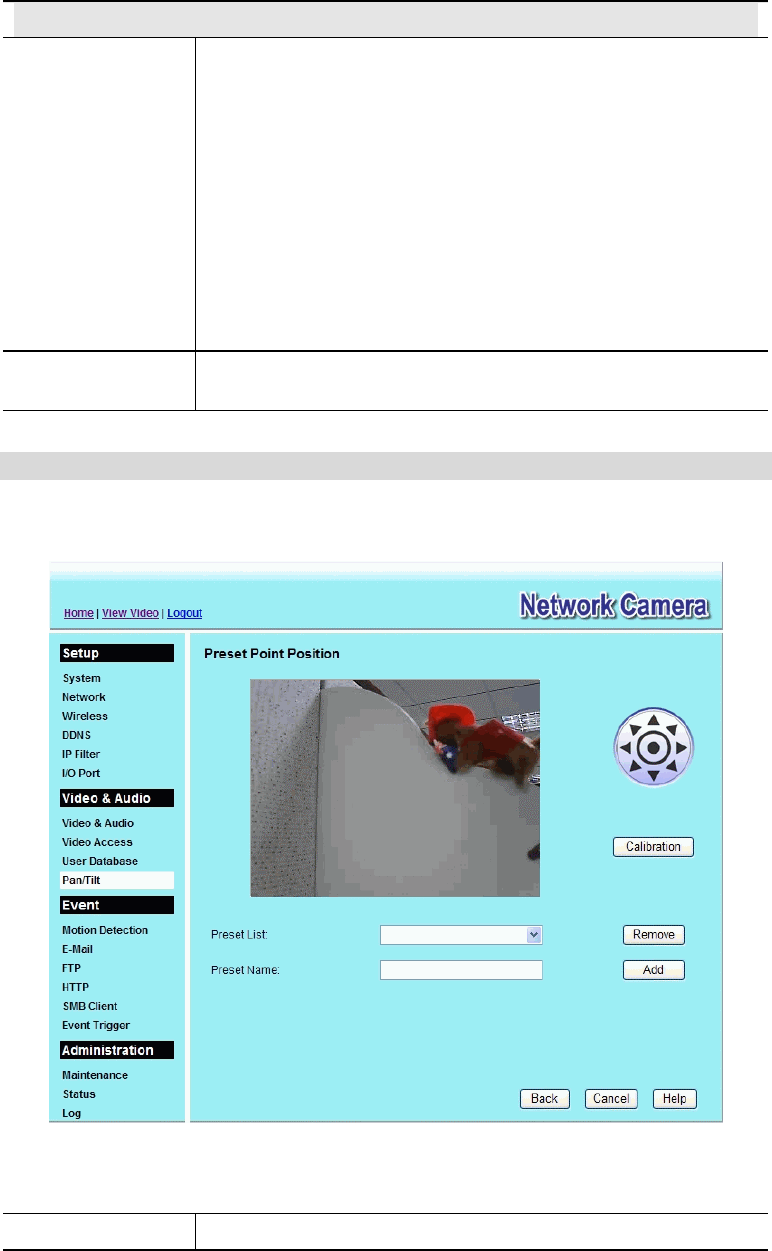
53
Set Patrol Sequence
Set Patrol Sequence This feature determines how the camera will move when it is set to
either "Once" or "Always" rotate. You can set a number of Preset
Positions; the camera will go to the first position, then move through
the list of present positions until it is finished. The camera will stop
at the last position in the list.
To create the Preset Sequence, select the desired Preset Position in
the left column, and click the "Add >>" button. Repeat until the
desired sequence is complete. Note that you can add the same Preset
Position more than once; this can be used to make the camera stay
longer at one position.
To delete a position from the Sequence, select the desired position
and click the "Remove" button.
Time This determines how long the camera will stay at each position
while executing the sequence. Set this to the desired value.
Set Preset Position Screen
This screen is displayed when the Preset Point Position button on the Pan/Tilt screen is
clicked.
Figure 37: Preset Point Position Screen
Data - Preset Point Position
Calibration Click this button to reset the calibration of Pan/Tilt area.

54
Preset List Select the desired Preset. The screen will update with the current
data for the selected Preset Position.
Preset Name Enter a suitable name for the Preset Position.
If no name is entered, the preset will have a number only.

55
Motion Detection Screen
This screen is displayed when the Motion Detection option on the Event menu is clicked.
.
Figure 38: Motion Detection Screen
Data - Motion Detection Screen
Motion Detection
Set Detection Areas You can set the full screen or selected areas of the video image
to be examined.
Note: Motion detection can be triggered by rapid changes in
lighting condition, as well as by moving objects. For this reason,
it should only be used indoors.
Indicator/Threshold Administrator needs to adjust the relation between indicator and
threshold for each area.
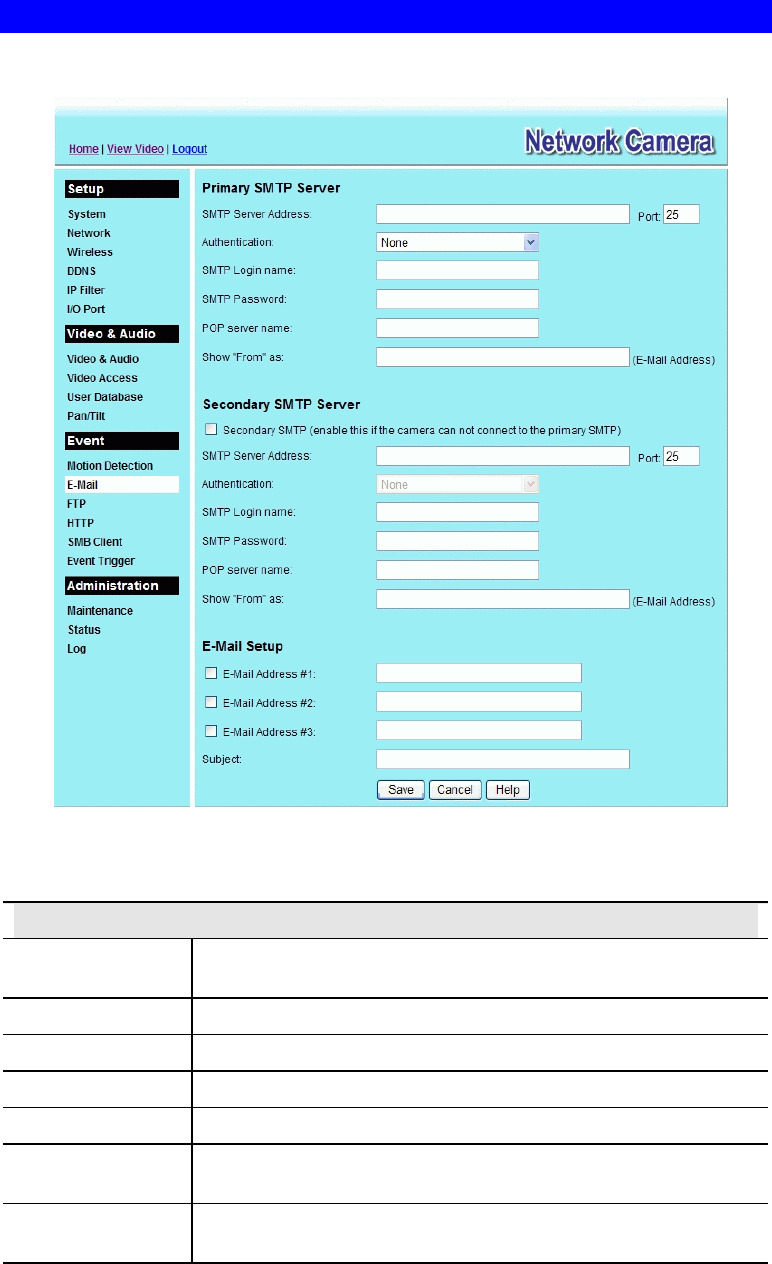
56
E-Mail Screen
This screen is displayed when the E-Mail option on the Event menu is clicked.
.
Figure 39: E-Mail Screen
Data - E-Mail Screen
Primary/Secondary SMTP Server
SMTP Server
Address Enter the address and port number of the SMTP (Simple Mail
Transport Protocol) Server to be used to send E-Mail.
Authentication Select the desired Authentication type for the SMTP Server.
SMTP Login name Enter your login name for the SMTP Server.
SMTP Password Enter your password for the SMTP Server.
POP server name Enter the name for the POP Server.
Show "From" as Enter the E-Mail address to be shown in the "From" field when the
E-Mail is received.
Secondary SMTP Check the box to upload to the Secondary SMTP if the camera can
not connect to the primary SMTP.

57
E-Mail Setup
E-mail Address Enter at least one (1) E-Mail address; the 2nd and 3rd addresses are
optional. The E-Mail alert will be sent to the E-Mail address or
addresses specified here.
Subject Enter the desired text to be shown as the "Subject" for the E-Mail
when it is received. Subject can not exceed 48 alphanumeric
characters.
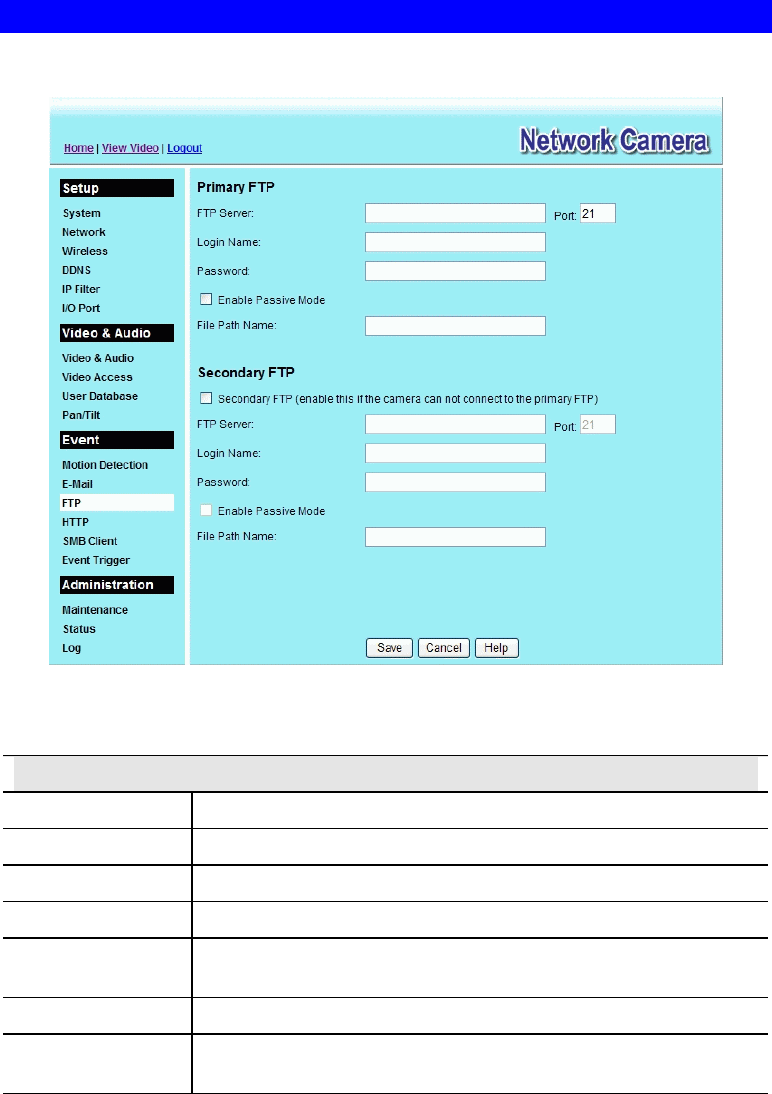
58
FTP Screen
This screen is displayed when the FTP option on the Event menu is clicked.
Figure 40: FTP Screen
Data - FTP Screen
Primary/Secondary FTP
FTP Server Enter the address of the FTP Server.
Port Enter the Port of the FTP Server to be connected.
Login name Enter your login name for the FTP Server.
Password Enter your password for the FTP Server.
Enable Passive
Mode Check the box to enable the Passive mode feature of the FTP.
File Path Name Enter the file path/name of the FTP.
Secondary FTP Check the box to upload to the Secondary FTP if the camera can not
connect to the primary FTP.
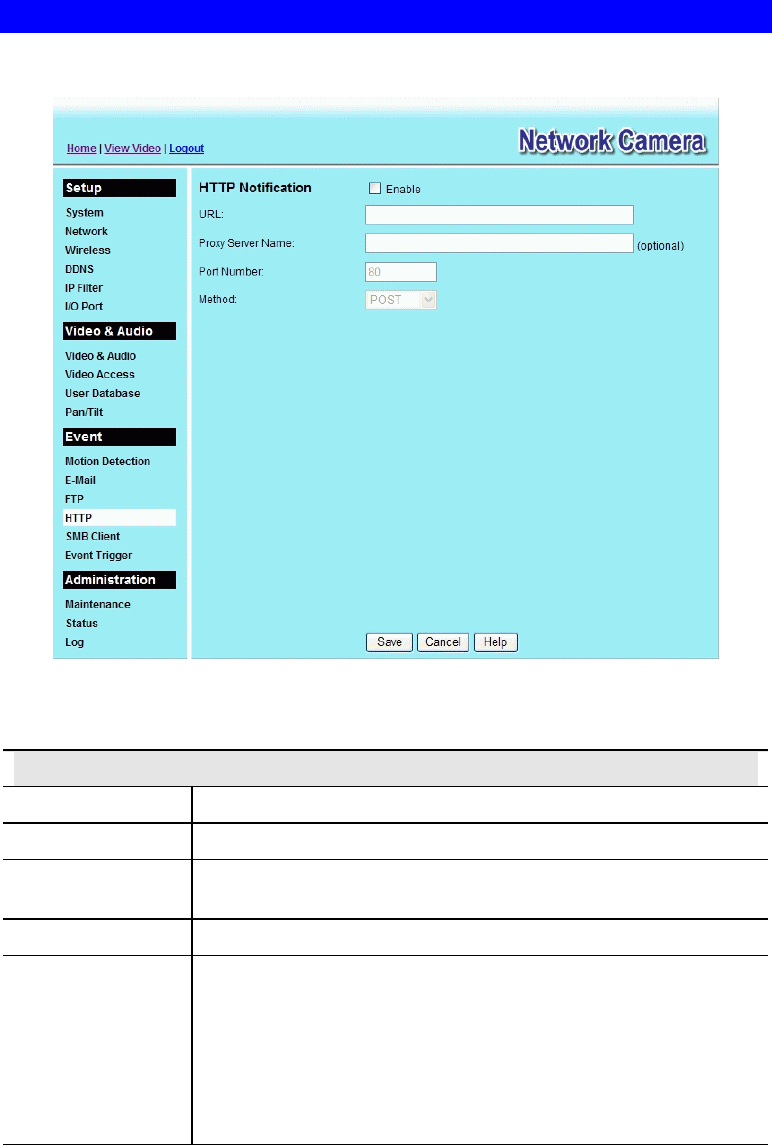
59
HTTP Screen
This screen is displayed when the HTTP option on the Event menu is clicked.
Figure 41: HTTP Screen
Data - HTTP Screen
HTTP Notification
Enable Enable this checkbox to use the HTTP Notification.
URL Enter the URL of your HTTP notification server.
Proxy Server
Name Specify the proxy server name in the provided field if the camera
needs to pass through a Proxy Server to do the HTTP notification.
Port Number Enter the port number for the proxy server.
Method Select the desired method of form data encoding.
• Get - It should be used if and only if the form processing is
independent, which typically means a pure query form.
Generally it is advisable to do so.
• Post - If there are problems related to long URLs and non-ASCII
character repertoires, which can make it necessary to use
"POST" even for independent processing.
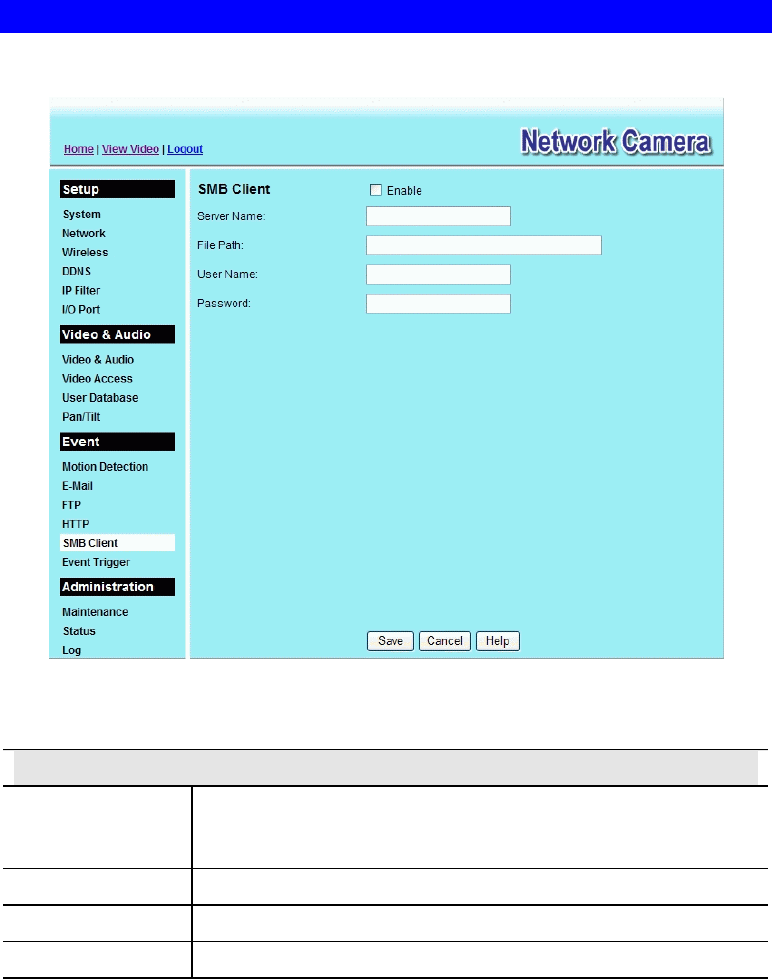
60
SMB Client Screen
This screen is displayed when the SMB Client option on the Event menu is clicked.
Figure 42: SMB Client Screen
Data - SMB Client Screen
SMB Client
SMB Client Enable this checkbox to use the SMB Protocol, which is a client
server, request-response protocol used for read, create, and update
files on the remote server.
File Path Enter the file path of your SMB server.
User Name Enter the user name for the SMB client account.
Password Enter the password for the SMB client account.
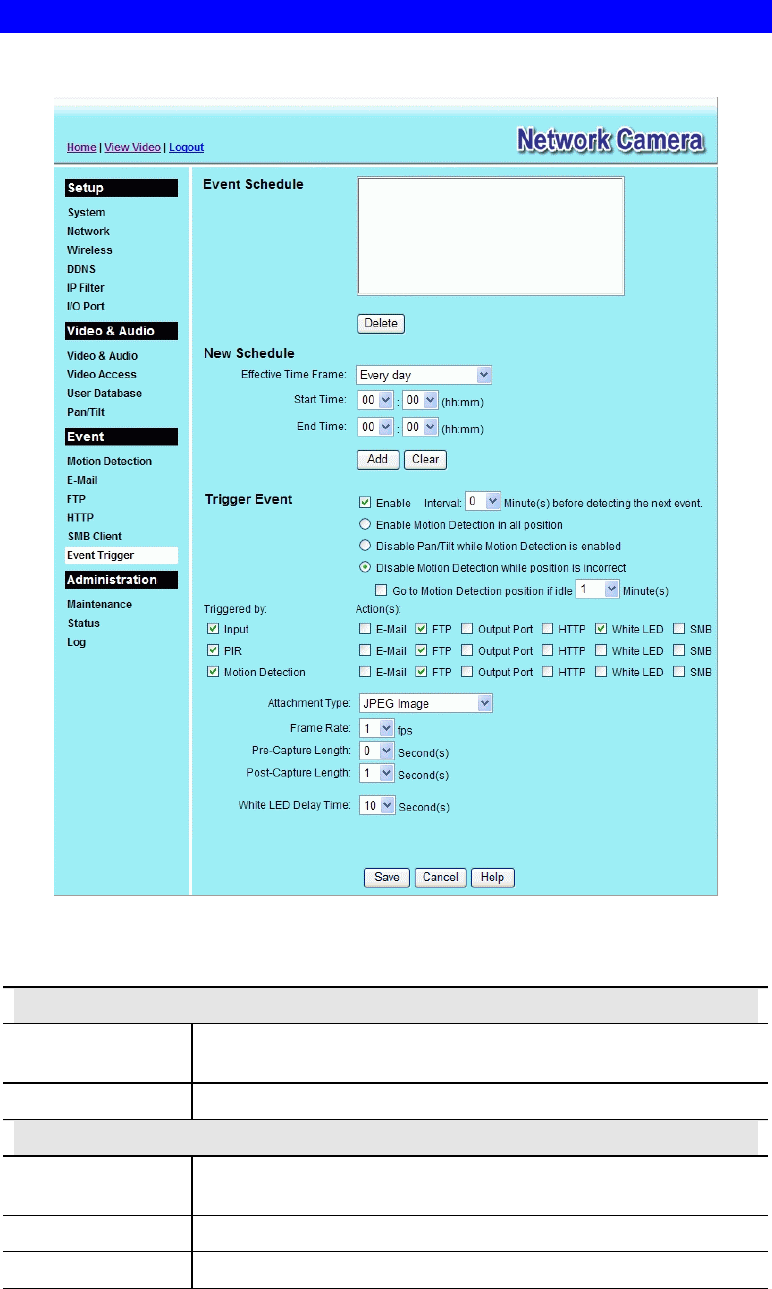
61
Event Trigger Screen
This screen is displayed when the Event Trigger option on the Event menu is clicked.
Figure 43: Event Trigger Screen
Data - Event Trigger Screen
Event Schedule
Schedule List The Event Schedule shows all of the event types currently
configured in the Network Camera.
Delete Button Click this button to delete the selected schedule in the list above.
New Schedule
Effective Time
Frame Choose the desired option for the period.
Start Time Choose the desired start time using a 24 hr clock.
End Time Choose the desired end time using a 24 hr clock.
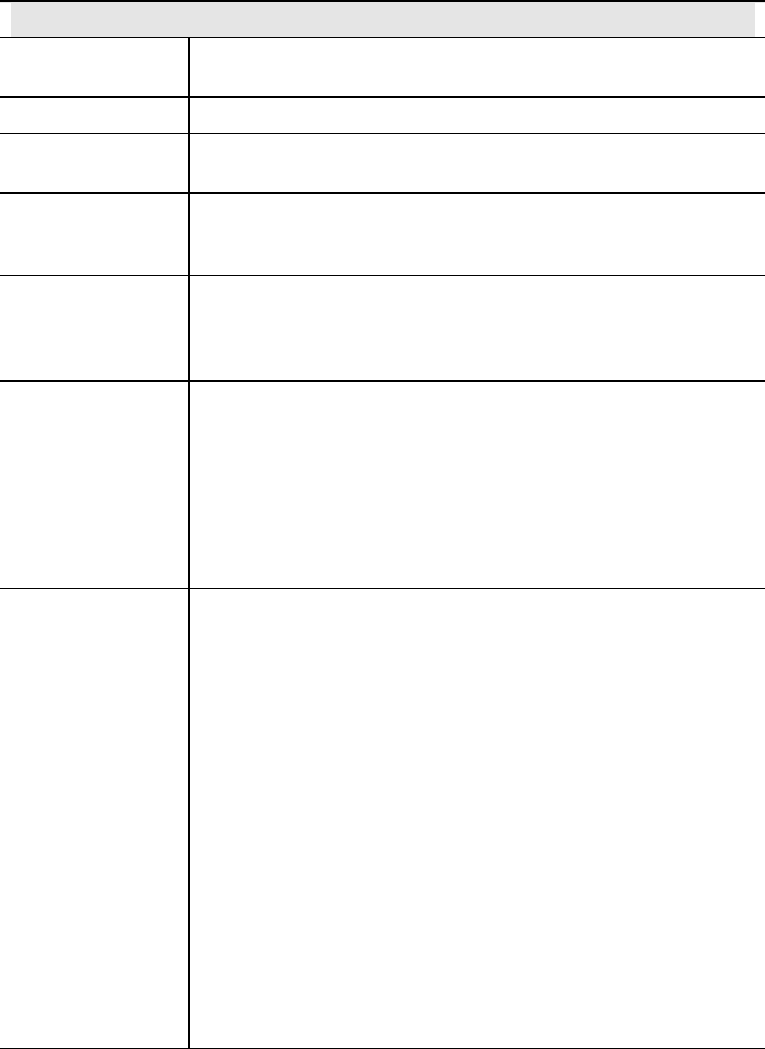
62
Trigger Event
Trigger Event Check to perform all of the event(s) that were configured and
scheduled.
Interval Select the desired option for the events interval. (* "0" = No Delay)
Enable Motion
Detection.. If enabled, movement in a motion detection window can be used to
trigger events.
Disable Pan/Tilt.. This option is only available if your camera is fitted with a Pan/Tilt
control. If available, select the desired option to resolve conflict
between the Pan/Tilt and Motion Detection features.
Disable Motion
Detection while.. If the checkbox is enabled, wrong movement in a motion detection
window can not be used to trigger events.
But if you enable the checkbox of Go to Motion Detection position if
idle and select the idle time, it will be used to trigger events.
Trigger by • Input - This describes the states that the input must be in for an
event to be triggered. Only one input can be used, also note that
the states for the input used must first be reached before the
event will be triggered.
• PIR - If the PIR sensor detects a human body, it will be used to
trigger events.
• Motion Detection - Movement in a motion detection window
can be used to trigger events.
Actions • E-Mail - If checked, an E-Mail (with "Attachment") will be
delivered to the SMTP server. (SMTP Server must be
configured on the E-Mail page.)
• FTP - If checked, an FTP upload will be activated to the FTP
server. (FTP servers must be configured on the FTP page.)
• Output Port - If checked, the output port state will be activated
as configured. (Output port must first be configured on the I/O
Port page.)
• HTTP - If checked, an Instant Messaging (IM) will be delivered
to the Jabber server. (Jabber server must be configured on the
Instant Messaging page.)
• White LED - If checked, the white LEDs will only be turned on
for certain period of time when the surrounding light is under
0.5 lux. You can configure the time in the White LED Delay
Time field below.
• SMB - If checked, JPEG image(s) or video files will be
uploaded to the SMB server. (SMB must first be enabled and
configured on the SMB Client page.)

63
Attachment Type • JPEG Image:
Frame Rate - Select the desired capture rate (1~5) for the JPEG
image(s) here.
Pre/Post Capture - Select the desired length. The snapshot(s) of
the JPEG image depends on this setting, and also the file size
and degree of compression.
• Video:
Video Format - Select the desired type for the video file.
Pre/Post Capture - Select the desired length. The size of the file
depends on this setting, and also the Video size and degree of
compression.
Note: The total length of Pre/Post Capture is 5 seconds that is limited
by the flash size.
White LED Delay
Time If the White LED is checked in the Action(s) section, select the
desired time option from the list.
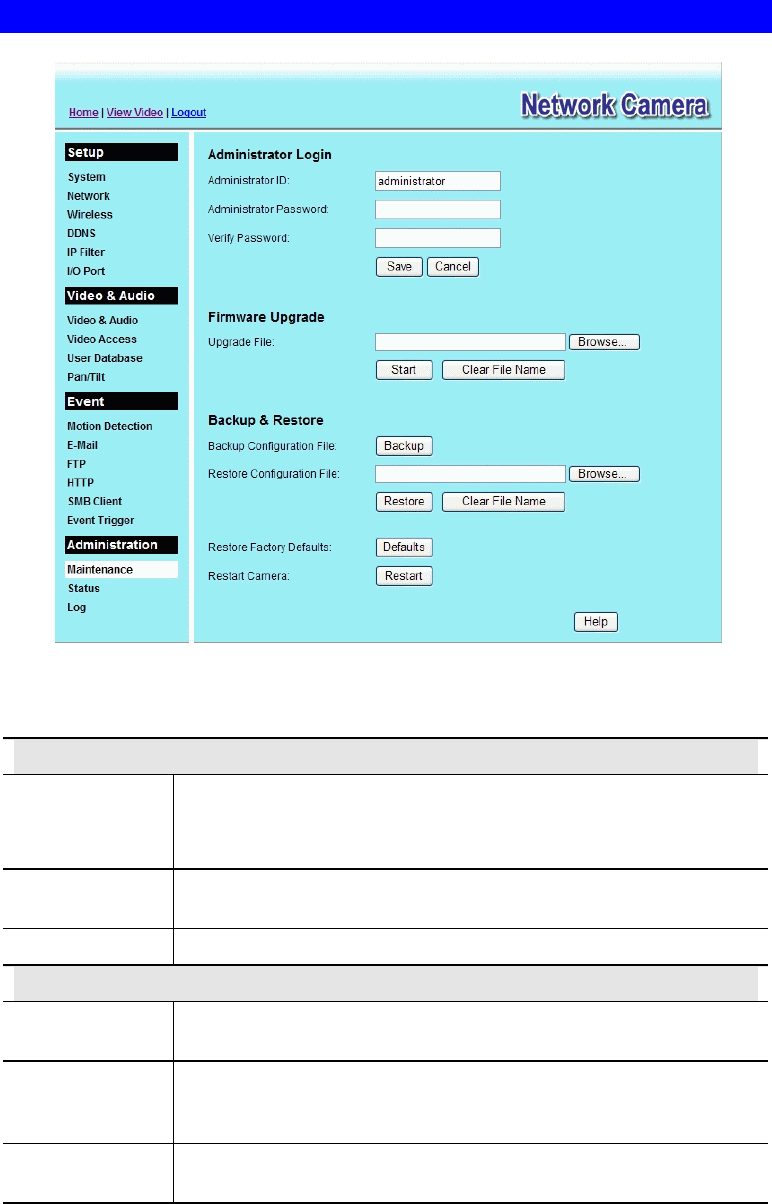
64
Maintenance Screen
.
Figure 44: Maintenance Screen
Data - Maintenance Screen
Administrator Login
Administrator
ID Enter the name for the Administrator here.
Spaces, punctuation, and special characters must NOT be used in the
name.
Administrator
Password The password for the Administrator.
Verify Password Re-enter the password for the Administrator, to ensure it is correct.
Firmware Upgrade
Upgrade File Click the "Browse" button and browse to the location on your PC
where you stored the Firmware file. Select this file.
Start Click this button to start the Firmware. When the upgrade is finished,
the Network Camera will restart, and this management connection will
be unavailable during the restart.
Clear File Name This does NOT stop the Upgrade process if it has started. It only clears
the input for the "Upgrade File" field.
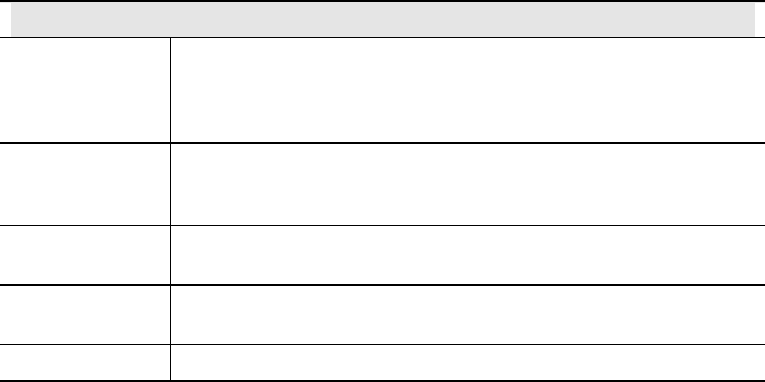
65
Backup & Restore
Backup
Configuration
File
Click Backup button to save the current configuration information to a
text file.
It is suggested to backup the configuration file, in order to restore the
camera easily.
Restore
Configuration
File
Click Restore button to reinitialize the camera to load the new updated
software. Do this after loading the upgrade file.
Clear File Name This does NOT stop the Restore process if it has started. It only clears
the input for the "Restore Configuration File" field.
Restore Factory
Defaults Click Defaults button to reloads all default settings on the camera.
Restart Camera Click Restart button to restarts the camera.
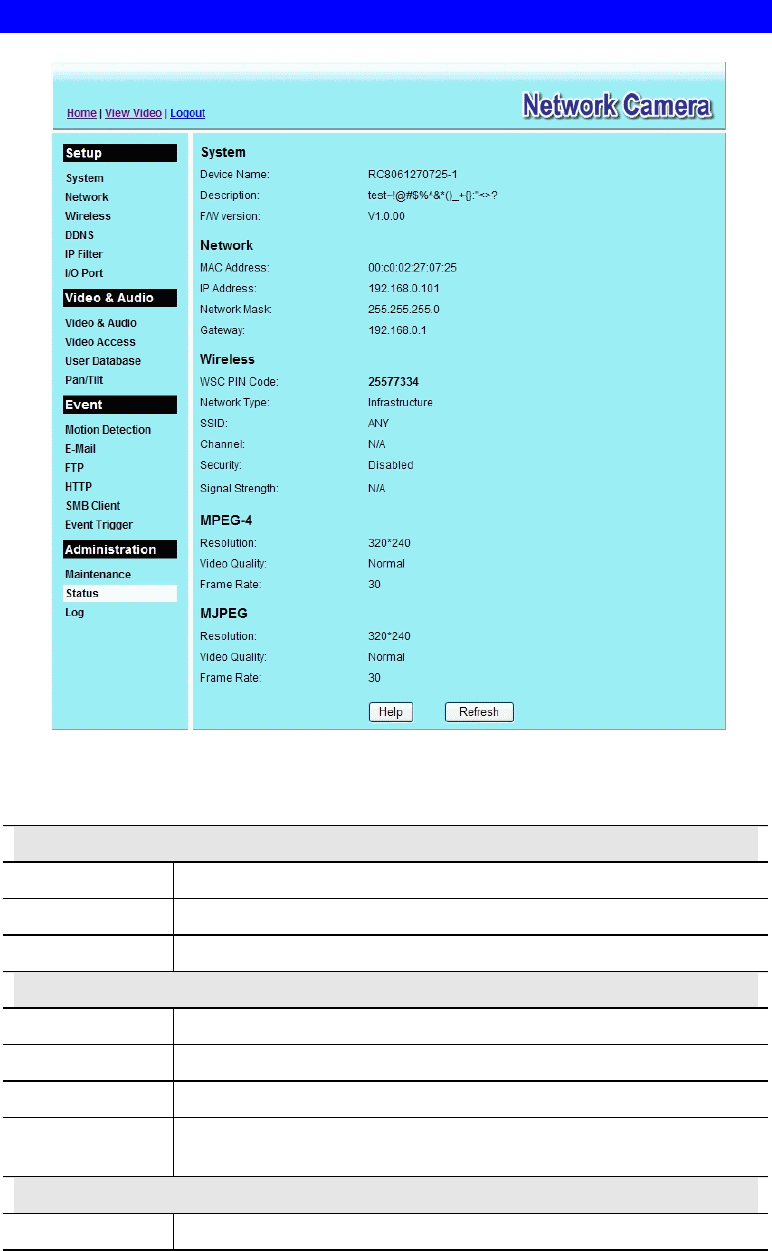
66
Status Screen
.
Figure 45: Status Screen
Data - Status Screen
System
Device Name This shows the name of the Network Camera.
Description This shows the description of the Network Camera, such as location.
F/W version The version of the current firmware installed.
Network
MAC Address The current IP address of the Network Camera.
IP Address The IP Address of the Network Camera.
Network Mask The network mask associated with the IP address above.
Gateway The IP Address of the remote Gateway associated with the IP Address
above.
Wireless (Wireless Model Only)
WSC PIN Dode It displays the current WSC PIN code.

67
Network Type This shows the Network Type currently in use (Ad-hoc or
Infrastructure).
SSID This displays the wireless SSID.
Channel This shows the wireless channel currently used.
Security The current security setting for Wireless connections.
Signal Strength This shows the strength of the signal.
MPEG-4/MJPEG
Resolution The image size of the video stream.
Video Quality This displays the image quality of the video stream.
Frame Rate This displays the frame rate of the video stream.
Buttons
Refresh Update the log and any other data on screen.
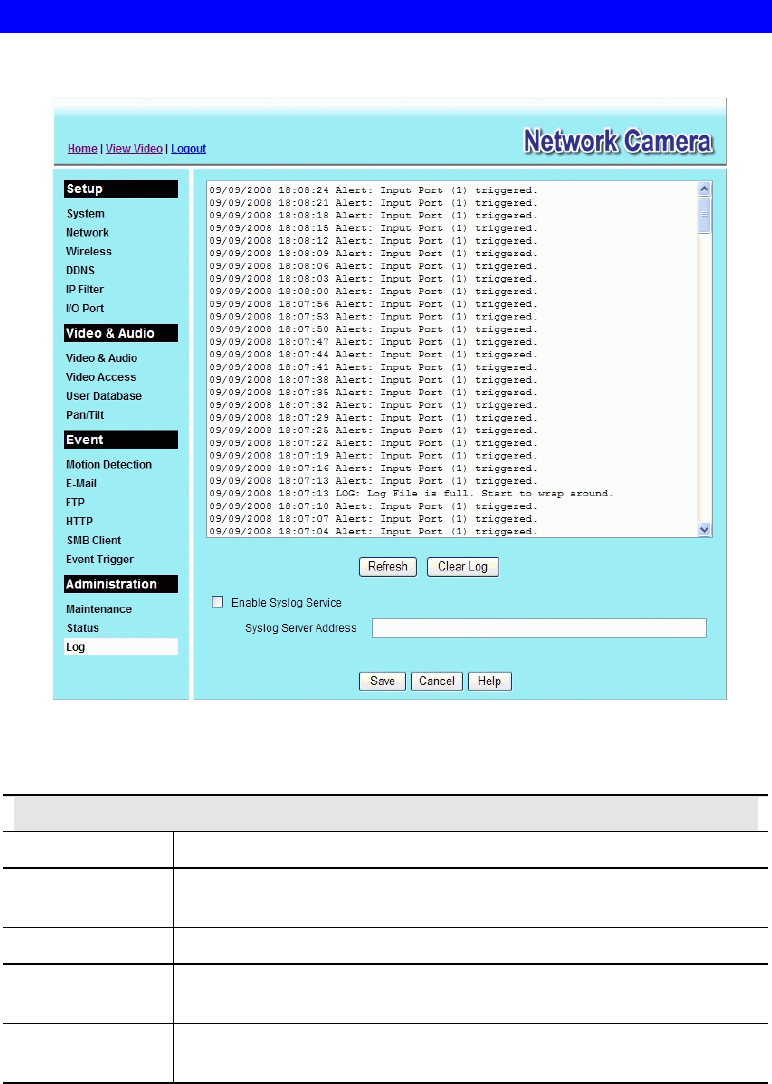
68
Log Screen
This screen displays a log of system activity.
.
Figure 46: Log Screen
Data - Log Screen
Log
System Log This is a log of system activity.
Refresh
Button Click this to update the data shown on screen.
Clear Log Click this button to restart the log.
Enable Syslog
Service Check the box to enable the System Log Server feature.
Syslog Server
Address Enter the address of the Syslog Server.
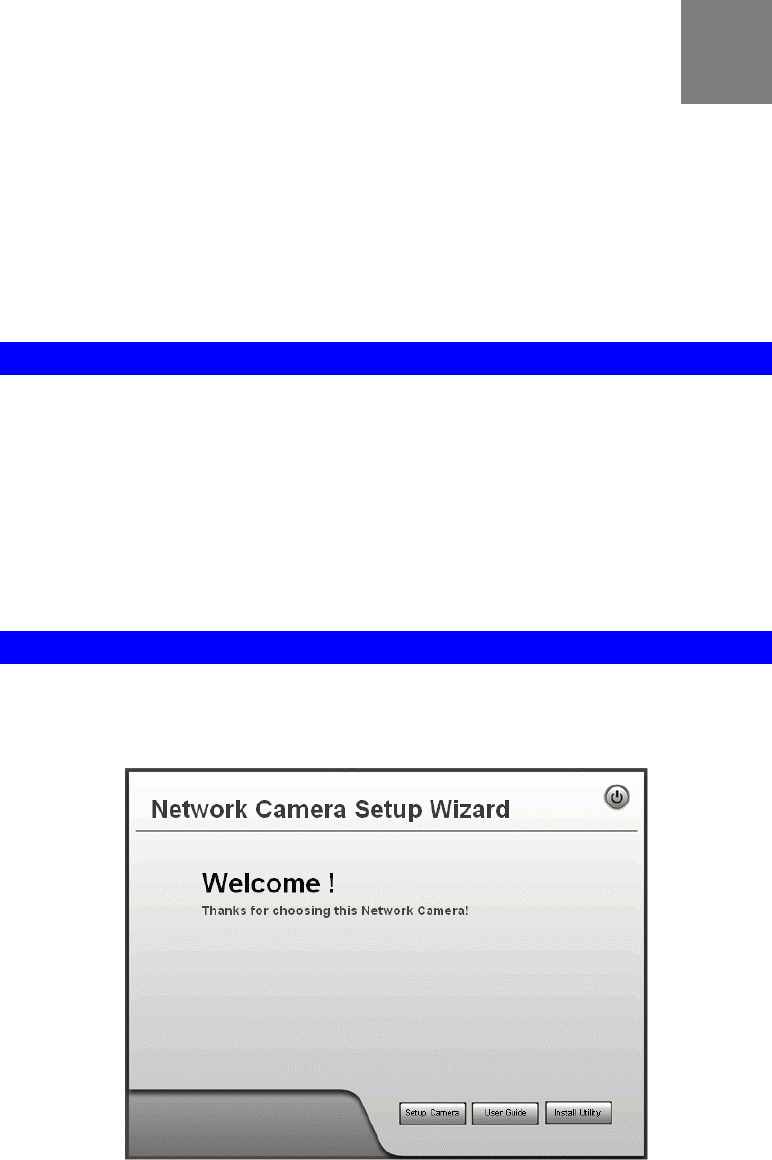
69
Chapter 6
Windows
Viewing/Recording Utility
This Chapter describes how to use the supplied Utilities package to view and
listen the live streams generated by the Network Camera.
Overview
The Utilities package includes following four functions:
• Monitor - to view/listen the live streams.
• Recorder - to record the live streams.
• Playback - to view the previous recordings.
• Configuration - to configure the Utilities such as adding camera, making recording
schedules and setting required parameters, etc..
The Utilities must be installed in the Windows before they can be configured.
Installation
1. Insert the supplied CD-ROM into your drive. If the setup program does not start
automatically, run NetworkCamera.exe in the root folder. You will see the Welcome
screen shown below.
Figure 47: Welcome Screen
2. Click the Install Utility button to start the installation of the Utilities package.
3. Follow the prompts to complete the installation.
6
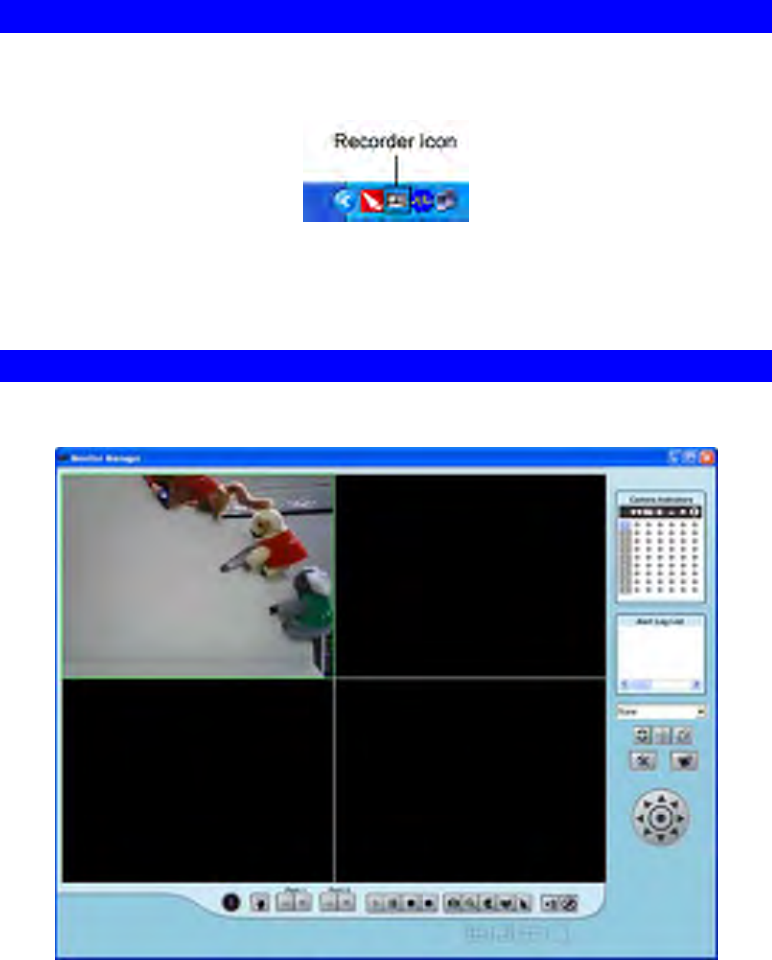
70
4. After the installation, double click the Monitor icon on the desktop or click Monitor menu
item in the Windows main program menu to launch the Utilities.
System Tray Icon
When started, the program will create an icon in the Windows system tray on the taskbar, as
shown below.
Figure 48: System Tray Icon
You can right click the icon and it will provides a menu which allows you to launch Playback
program, view the recording schedule details or even exit the Utilities package.
Main Screen
When Utilities launched, the Monitor Manager screen like the example below will be displayed.
Figure 49: Main Screen
If no cameras have been defined and added to the Utilities, no video will be displayed. Utilities
should be configured first to view the camera streams. See the following section for
information on defining a camera. Note that each Camera is given a number (Channel Number).
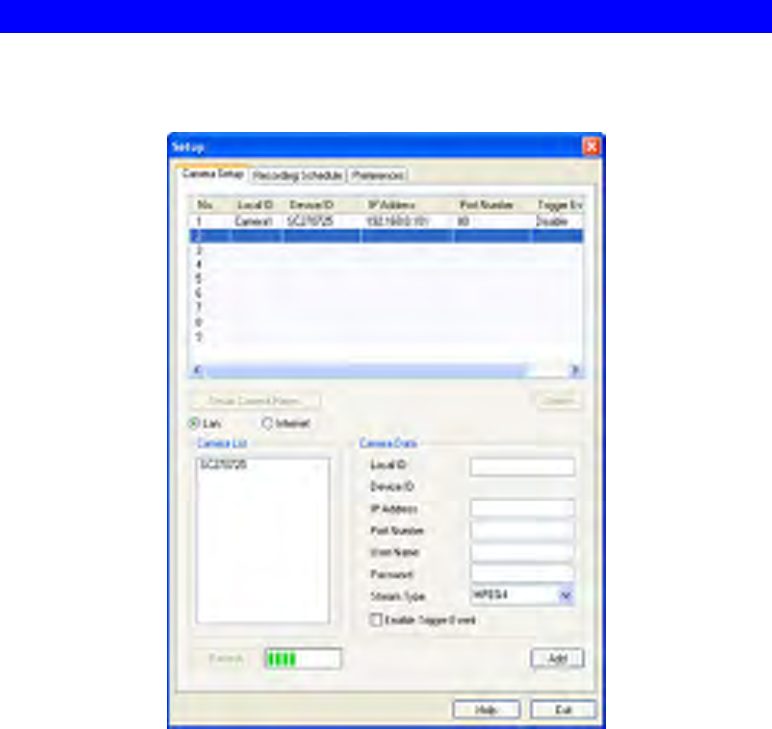
71
Camera Setup
To define a camera and associate it with a Channel Number.
1. Click the Setup button on the main screen. You will see a screen like the example below.
Figure 50: Camera Setup Screen
2. Select the desired Channel number in the left (No.) column.
3. There are 2 radio buttons, for LAN or Internet. The default is LAN. See the following
section for details of the Internet option.
• The LAN panel, on the left, displays all available Network Cameras found on your
LAN automatically. This list can be updated by clicking the Refresh button. The
progress bar appears for initial use or clicking the Refresh button.
• The Camera Data panel, on the right, displays the data for the selected camera.
4. To associate a camera with the current Channel:
• Select a camera in the list on the left.
• It is required to enter the unique value of Local ID.
• Check that the Camera Data shown on the right is correct. Enter associated User
Name and Password.
Note: The IP Address, Port Number, User Name and Password can only be
modified in the WEB UI instead of Camera Setup screen. You can click the Setup
Camera Pages button to the WEB UI screens.
• Click the Add button. The camera will now appear in the Channel List.
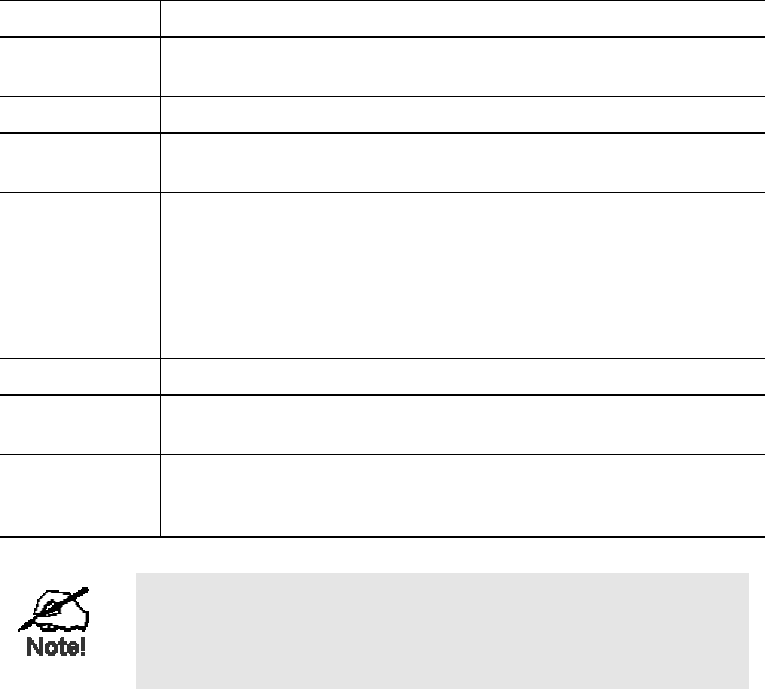
72
Camera Data - LAN
Local ID This is the name you gave to this camera. This field must be entered.
Device ID This is the default name for the Wireless Network Camera, and cannot
be changed.
IP Address The current IP address of the Wireless Network Camera.
Port Number This will normally display "80". Only change this if requested to do so
by the Wireless Network Camera Administrator.
Login The camera Administrator can require that users provide a username and
password before being allowed to view the live video.
• If the Administrator has not enabled this option, the Login fields can
be left blank.
• Otherwise, you must enter the username and password allocated to
your by Administrator.
Stream Type Select the desired type from the drop-down list.
Setup Camera
Pages Click this button to connect the Web-based interface of the Camera.
Enable Trigger
Event Check this if you want the Utilities to enable event triggered recording.
Note: Event trigger setting in the camera must also be enabled to let the
event triggered recording of Utilities take effect.
You can add the same Camera twice, once for the LAN (using
the LAN IP address), and again for the Internet (using the
Internet IP address). This will allow viewing the camera whether
you are on the same LAN as the camera or in a remote location.
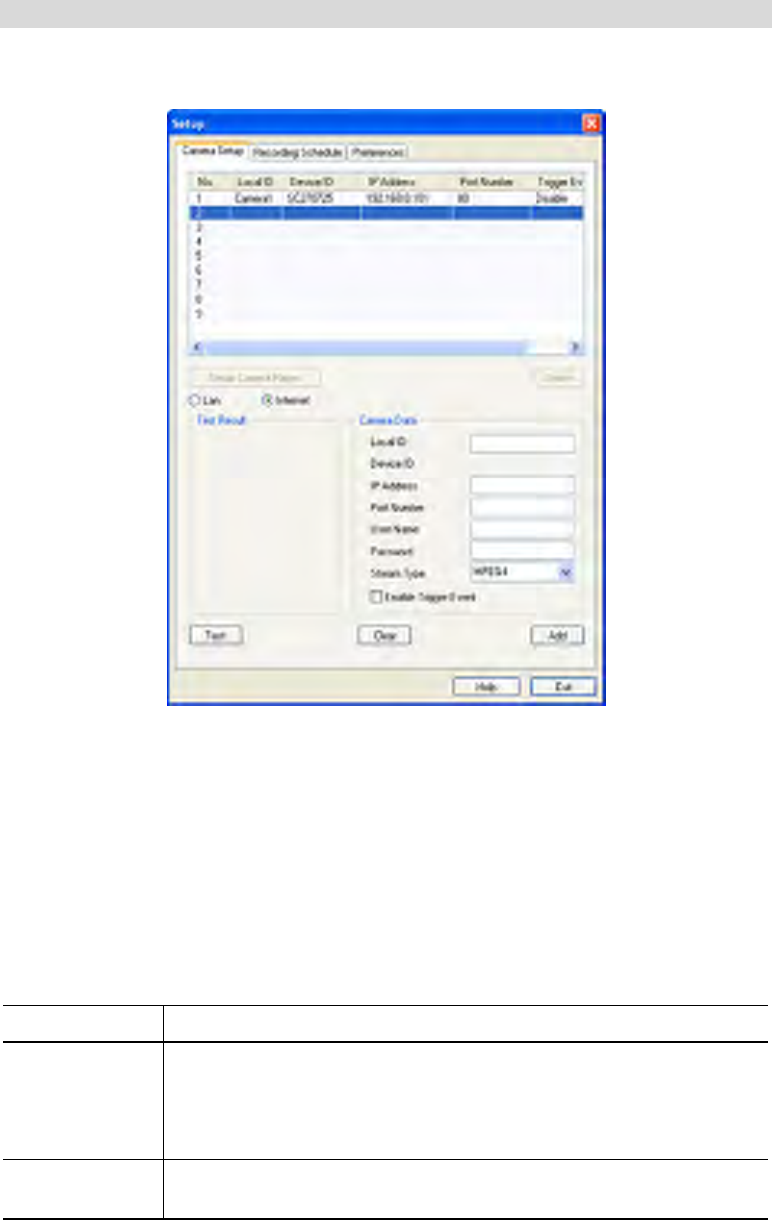
73
Adding Cameras on the Internet
If the Wireless Network Camera you wish to add is not on your LAN, but is available via the
Internet, click the Internet button. You will see a screen like the example below.
Figure 51: Add Camera from Internet
To associate a camera with the current Channel:
1. Enter the Local ID, IP Address, Port Number, User Name and Password in the Camera
Data section manually.
2. Click the Test button to check that a connection and login can be performed successfully.
Note that if the remote LAN does not currently have an Internet connection, or the remote
camera is not on-line, the test will fail because no connection is possible.
3. Click the Add button. The camera will now appear in the Channel List.
Camera Data - Internet
Local ID This is the name you gave to this camera. This field must be entered.
Device ID This is the default name for the Wireless Network Camera, and cannot
be changed.
This field will be displayed automatically once a connection to the
Wireless Network Camera has been established.
IP Address Enter the Domain Name or Internet IP address of the desired Wireless
Network Camera.
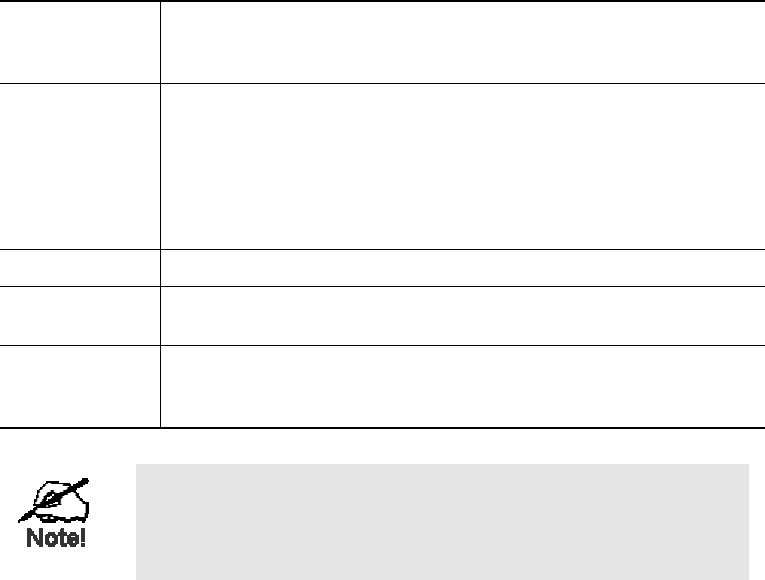
74
Port Number Enter the port number used by the Wireless Network Camera for
connections via the Internet The Camera Administrator can advise you
of the port to use. The default value is 1024.
Login The camera Administrator can require that users provide a username and
password before being allowed to view the live video.
• If the Camera Administrator has not enabled this option, the Login
fields can be left blank.
• Otherwise, you must enter the username and password allocated to
you by the Camera Administrator.
Stream Type Select the desired type from the drop-down list.
Setup Camera
Pages Click this button to connect the Web-based interface of the Camera
Enable Trigger
Event Check this if you want the Utilities to enable event triggered recording.
Note: Event trigger setting in the camera must also be enabled to let the
event triggered recording of Utilities take effect.
You can add the same Camera twice, once for the LAN, and
again for the Internet. This will allow viewing the camera
whether you are on the same LAN as the camera or in a remote
location.
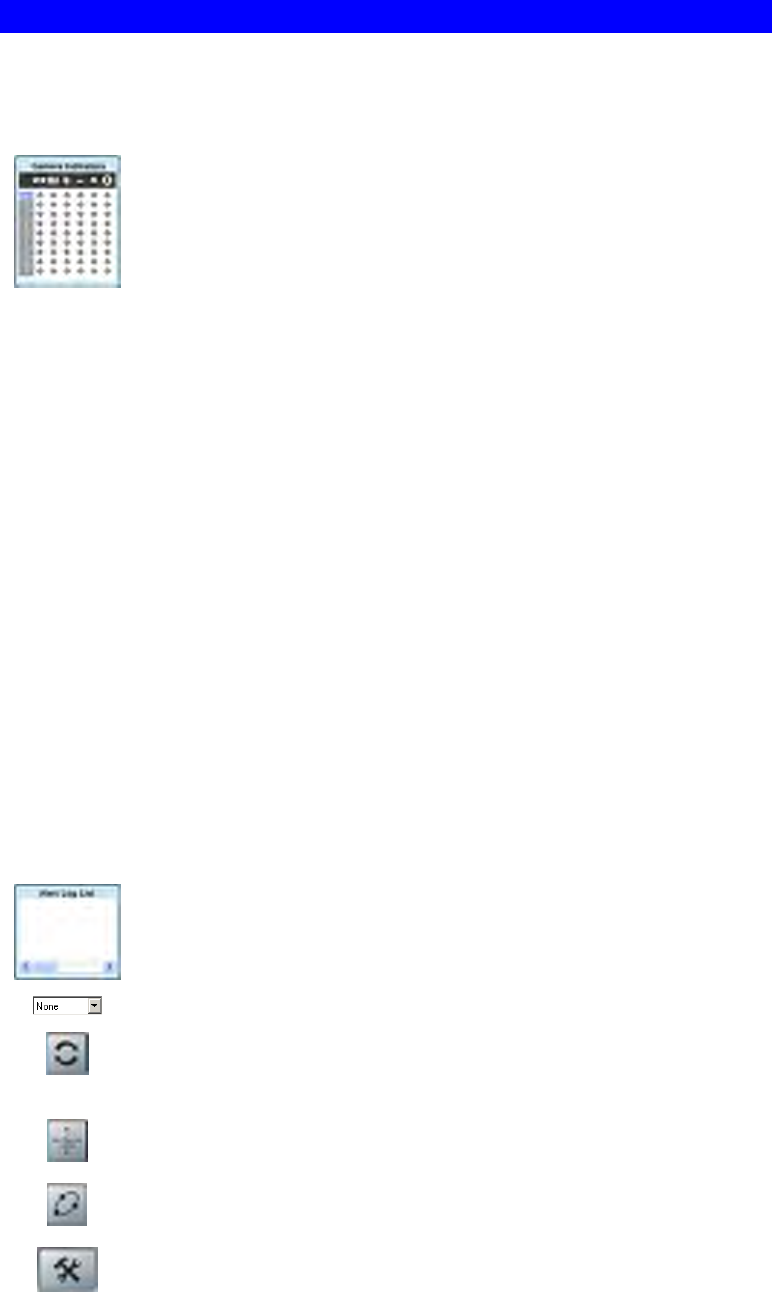
75
Monitor Program - for Streams Live Viewing
You can view live video in the Monitor screen. The built-in software can let you view up to 9
cameras on a single computer screen at one central location.
The following table lists the icons displayed on the Monitor screen:
Channel (Camera) Selection.
Use this to select the desired Channel (Camera) by clicking on the top row.
This panel also indicates the status of the camera.
• The First column indicates if the associated channel number has a
configured camera or not.
Blue indicates a camera has been configured for the channel.
Gray indicates no camera is configured for the channel.
User can drag a blue button to a desired viewport to let the camera
stream be displayed in the desired viewport.
• The View column indicates if the camera stream is being viewed.
Green indicates the configured camera is being viewed.
Gray indicates that no camera is configured or the configured camera is
not connected to the Monitor.
• The Instant Record column indicates if a recording is in progress.
Gray indicates no recording.
Red indicates recording is in progress.
• The Motion Detection column indicates if Motion event detected in the
associated channel.
Yellow indicates Motion Detection is in progress.
Gray indicates this feature is not enabled.
• The I/O columns indicate if there is any I/O type triggered event
detected in the port 1/2.
Yellow indicates there is an I/O type trigger event detected.
Gray indicates there is no new I/O type trigger event detected.
When user clicks on the Alert Log List, all the trigger event indicators
such as motion, I/O for the associated focused channel will turn to gray.
• The PIR column indicates if there is any PIR triggered event detected.
Yellow indicates there is a PIR trigger event detected.
Gray indicates there is no new PIR trigger event detected.
Alert Log List.
It displays the list of triggered events, if any, for the focused viewport.
Preset Position. Select the desired Preset position.
Refresh. Update the Preset position list. This has no effect unless during
the viewing session, another user or the Camera Administrator has renamed
one or more of the Preset positions.
Create Preset Points. Define (or re-define) a Preset position. The Camera
Administrator can choose whether or not this option is available.
Patrol. Move through the Preset positions in the sequence defined by the
Camera Administrator.
Setup. Click this button to open the Utilities configuration program.

76
Playback. Click this button to launch the Playback program, which allows
you to browse through the previously saved recordings. Please see the
"Playback Program - for Streams Playback" section for details.
Move Control. Use this to move the camera to the desired position. There
may a short delay after clicking the desired icon. You should wait a couple
of seconds rather than click again.
Channel Indicator. This indicates the current channel (camera).
White Light. Click the button to turn on/off the white light LEDs.
Port 1. Click the buttons to set the I/O port 1 to ON or OFF mode.
Port 2. Click the buttons to set the I/O port 2 to ON or OFF mode.
Play. Use this to re-start viewing, after using the Stop or Pause button.
Pause. Use this to temporarily stop the playing of focused viewport.
Stop. This will terminate the connection to the camera, halting both the
viewing and the instant recording (if in progress).
Record. Click this to start recording the current stream. While recording,
this button will be red. To stop recording, click the Stop button. To pause
the playing, press Pause button.
Snapshot. Click this to take a still image of the current video stream. The
image format could be BMP or JPEG depending on user’s selection.
Zoom Camera. A digital zoom-in feature is available. To zoom in a
viewport:
1. Click this icon. Then move the mouse to the area to be magnified.
2. Left click the mouse to magnify the viewport to x2 rate.
3. Repeat steps 1) and 2) to magnify the viewport to x4 rate.
4. Click the icon again to back to normal viewport display rate.
Flip Video. Click this to have the image swapped top-to-bottom.
Mirror Video. Click this to have the image swapped left-to-right.
Direct Pan/Tilt. Use this to move the camera to the Pan/Tilt position
directly.
Sound On/Off. To turn On/Off the audio volume for the camera in focused
viewport.
Microphone On/Off. To turn On/Off the audio upload function for the
camera in the focused viewport.

77
Volume. If Sound/Microphone is enabled, you can right click the icon(s),
then drag and drop to raise or lower the volume.
Screen Layout. Use this to select the number of Channels (Cameras) to be
displayed on screen. Up to 9 cameras can be displayed.
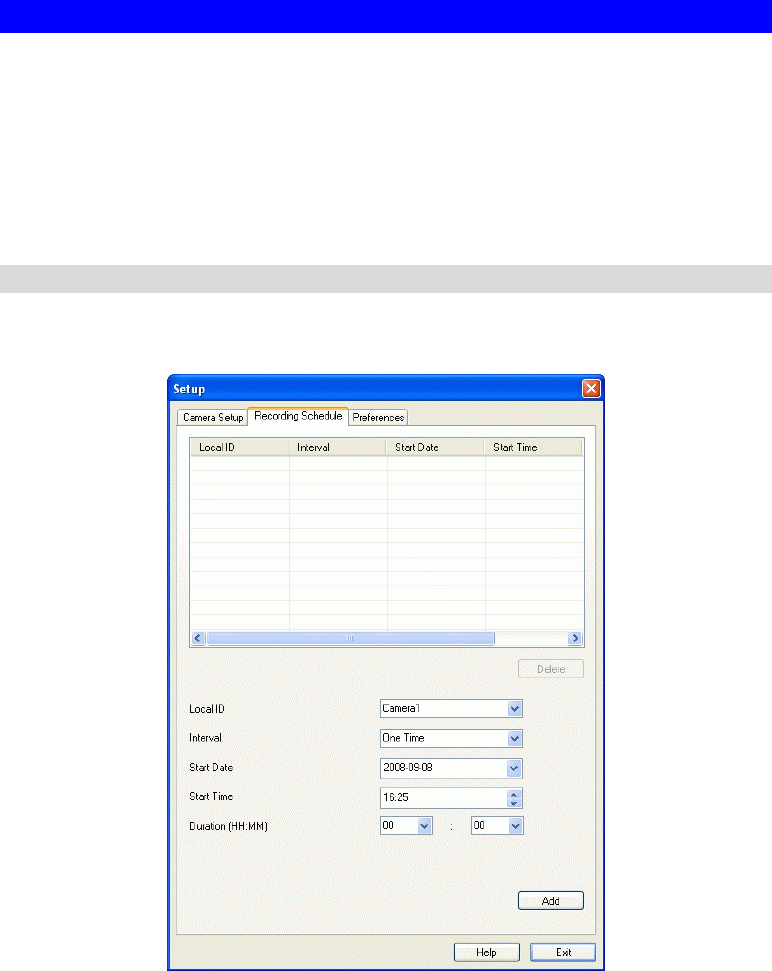
78
Recorder Program - for Streams Recording
You can record the streams from camera by pressing the Record button in the Monitor program
as mentioned in the "Monitor Program - for Streams Live viewing" section or by making
schedules to let the recording happen on the arranged time period.
All the recorded streams are stored in files with a proprietary format and can be viewed via
Playback program in the Utilities package.
If you want to change the default settings of recording parameters before doing any recording,
please see the "Preferences" section for details.
Recording Schedule
To make recording schedules, click the Recording Schedule tab on the Setup screen. You will
see a screen like the example below.
Figure 52: Recording Schedule
If necessary, change these settings to suit your environment. Please follow the steps below to
make a schedule for recording:
1. Select a camera from the available camera list labeled Local ID.
2. Select a recording type from the Interval list box.
3. Select the recording time range from Start Date, Start Time and Duration list boxes.
4. Press Add button to add the schedule. There are up to ten schedules could be added for
each camera.
You will see all the schedules in the recording list.
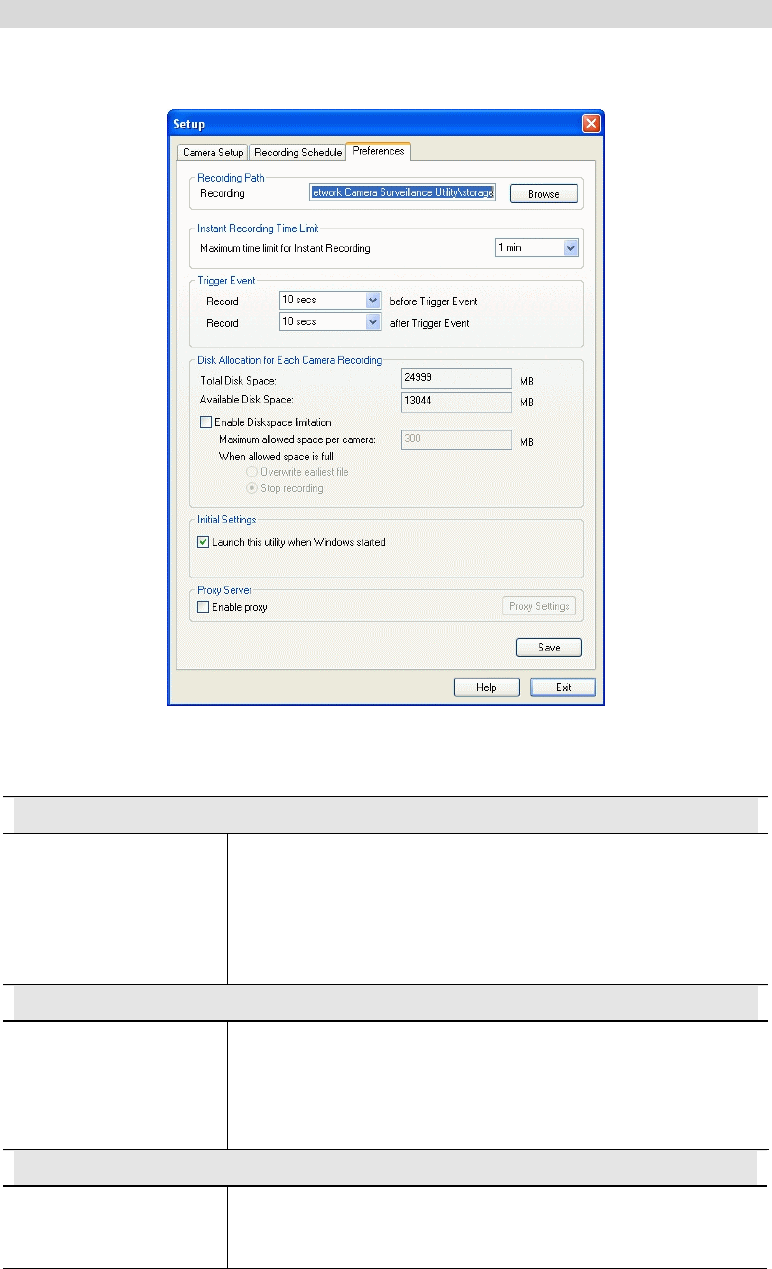
79
Preferences
Clicking the Preferences tab on the Configuration program to make change of default Utilities
parameter settings.
Figure 53: Preferences Screen
Data - Preferences
Recording Paths
Recording This is the Drive and Folder on your PC/Notebook where
recorded files will be placed. You need a drive which has large
amounts (Gigabytes) of free space. Click the Browse button to
select the drive and folder if you want to change the default
path. Note that file names for the recordings are automatically
assigned, using an internal date-time coding rule.
Instant Recording Time Limit
Maximum time limit
for Instant Recording This sets the maximum time period of a recording which is
started by clicking the Record button on the Monitor main
screen. If the recording is not stopped manually before the
arranged time period elapsed, it will be terminated automatically
when the end time hit.
Trigger Event
Record before Trigger
Event Set the time so that the Recorder will make a pre-recording for
at most the specified time range while a triggered event
detected.
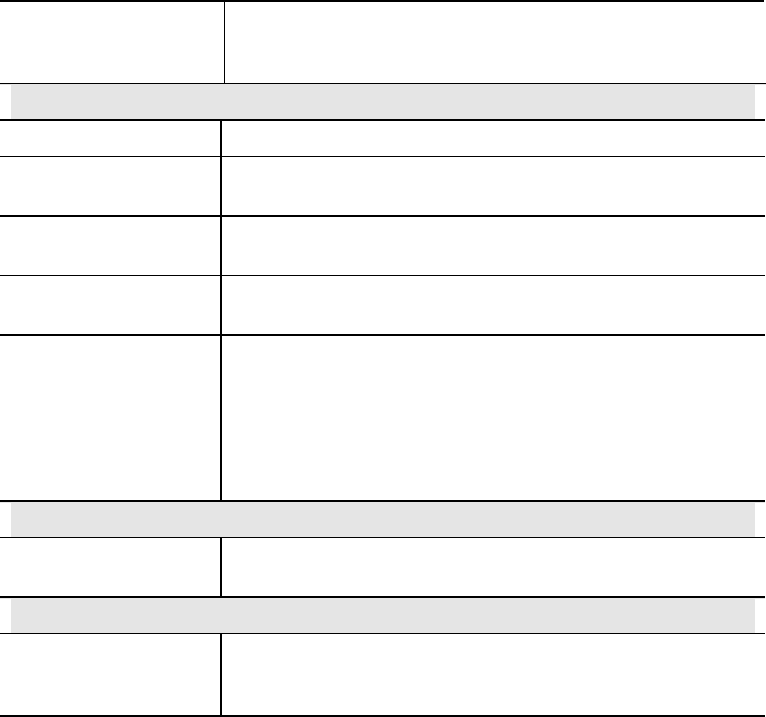
80
Record after Trigger
Event Set the time so that the Recorder will make a post-recording for
at most the specified time range while a detected triggered event
ends.
Disk Allocation for Each Camera Recording
Total Disk Space This displays the total size of the selected disk.
Available Disk Space This displays the available space of the selected disk for storing
recordings.
Enable Disk space
limitation Enable this if you wish to limit the disk space used by video
recordings.
Maximum Allowed
Space Enter the maximum amount of disk space assigned to each
camera for stream recordings.
When allowed space
is full. Select the desired option for the behavior when the disk space
limit is reached.
• Overwrite earliest file. The Recorder will overwrite the
oldest file if the space is not enough for further recording.
• Stop Recording. If the disk space limit is reached, no
further recording is done.
Initial Settings
Launch this utility
when Windows started Check this to have this utility start when Windows starts.
Proxy Server
Enable proxy If enabled, click the Proxy Settings button to configure the proxy
server/exception list settings. Enter the address and port number
for the proxy server in the proxy sub-screen.
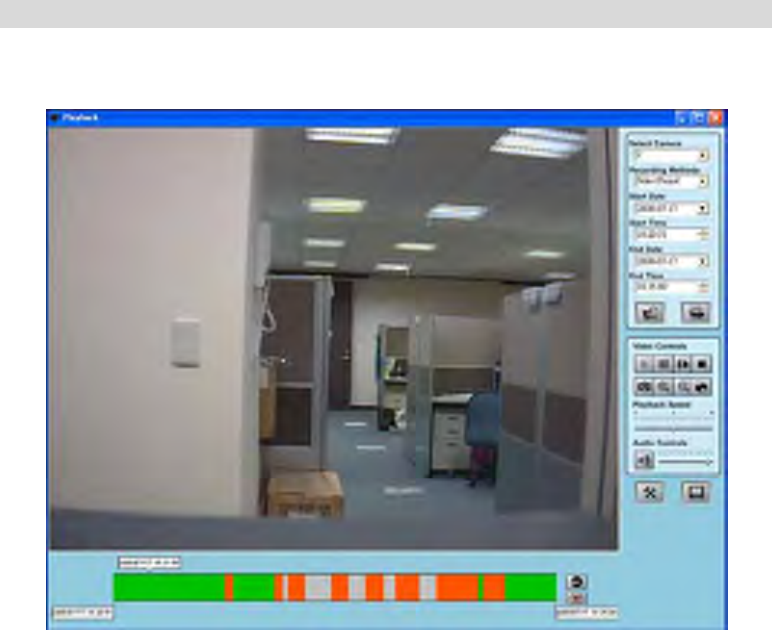
81
Playback Program - for Recordings Playback
To access the saved recordings of the Cameras, click Playback button in the Monitor main
screen, then you will see a screen like following.
Figure 54: Playback Screen
Searching Recorded Streams Files
Select Camera. Select the desired camera from the list.
Recording Methods. Select the type of the recorded file from the drop-down list that you wish
to view.
Start Date/Time. The start date and time the recordings will be searched.
End Date/Time. The end date and time the recordings will be searched.
Load other Cameras. Click this button to load other recordings made from cameras outside of
the current folder where the Utilities was installed.
Submit. Click this button to confirm the file searching criteria then the Playback will display a
list of files matched with the search criteria on the recording bar.
Play. Use this to re-start viewing, after using the Stop or Pause button.
Pause. Use this to temporarily stop playing.
Frame by Frame. Playback will display the video stream in a one-frame per mouse clicking
mode.
Stop. This will stop playing the recording.
Snapshot. Click this to take a still image of the current video.
Zoom In. To zoom in on a section of the window, click this icon.
Zoom Out. To zoom out on a section of the window, click this icon.
82
Print. Click this to print the current video stream.
Playback Speed. To play a recorded file, select the desired speed.
Audio Control. To play a recorded file, select the desired volume.
Delete Video. To delete a recorded file, select the file and click this button.
Recording Bar. It displays the recordings that match your requests.
• Green color indicates the schedule and instant recordings.
• Orange color indicates Motion triggered recordings.
• Blue color indicates I/O triggered recordings.
• Red color indicates PIR triggered recordings.
• Gray color indicates no recording found.
Available Operation on Recording Bar.
It is possible to drag an area on the Recording Bar to narrow the time range selection.
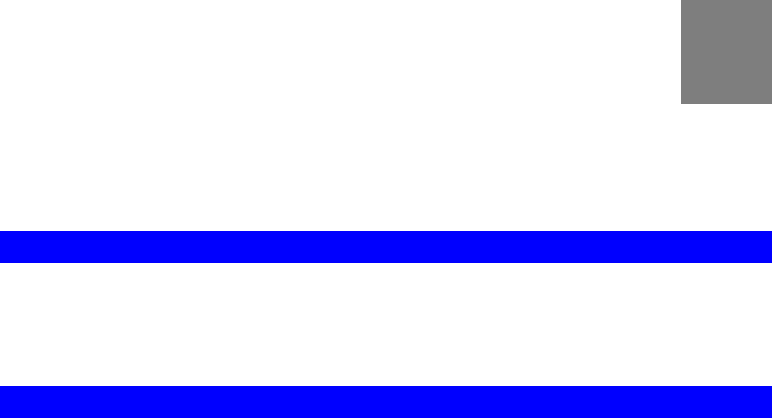
83
Chapter 7
Troubleshooting
This chapter covers the most likely problems and their solutions.
Overview
This chapter covers some common problems that may be encountered while using the Network
Camera and some possible solutions to them. If you follow the suggested steps and the
Network Camera still does not function properly, contact your dealer for further advice.
Problems
Problem 1: I can't connect to the Network Camera with my Web Browser to
configure it.
Solution 1: It is possible that your PC's IP address is not compatible with the IP
address of the Network Camera.
Use the Windows utility to configure the Network Camera with a valid IP
address.
Problem 2: The Windows utility doesn't list any Network Cameras.
Solution 2: Check the following:
• The Network Camera is installed, LAN connections are OK, it is
powered ON and startup is complete.
• Ensure that your PC and the Network Camera are on the same network
segment. (If you don't have a router, this must be the case.)
• Ensure that your PC has the TCP/IP network protocol loaded. In
Windows, this is done by using Control Panel-Network.
• If an entry for TCP/IP -> Network card is not listed, use Add -
Protocol - Microsoft - TCP/IP to add it.
• You then need to select the new entry (TCP/IP -> Network card),
click Properties, and configure the IP Address tab.
• If your LAN has a DHCP Server, you can select "Obtain an IP
Address automatically". Otherwise, you must select "Specify an
IP Address", and enter values for IP Address, Subnet Mask, and
Gateway. All devices on your LAN must use compatible values.
Remember that each device needs a unique IP Address, and the
same Subnet Mask.
Problem 3 When I try to connect to the Network Camera, I get prompted for a
user name and password.
Solution 3 You SHOULD be prompted for a user name and password if trying to
access the Administration menu.
Enter the Administrator ID and Password set on the Maintenance screen.
If you are just trying to view Video, the User Name/Password prompt
7
84
indicates that the Administrator has restricted access to specified users.
Ask the Administrator for your User Name and Password.
Problem 4 I can't connect to the Network Camera using a Wireless connection.
Solution 4 1) If a LAN cable is connected to the LAN port, the Wireless interface is
disabled. Only one interface can be active.
2) Check that your PC and the Network Camera have compatible Wireless
settings.
• Mode (Infrastructure or Ad-hoc) must be correct.
• ESSID must match.
• WEP settings must match.
• In Ad-hoc mode, the Channel should match, although this is often not
required.
Problem 5 Video quality may suddenly deteriorate.
Solution 5 This can happen when an additional viewer connects to the Network
Camera, overloading the camera or the available bandwidth. The image
size and quality can be adjusted to cater for the required number of viewers
and the available bandwidth.
Problem 6 The motion detection feature doesn't send me any E-Mails.
Solution 6 It may be that the SMTP (Simple Mail Transport Protocol) server used by
the camera to send the E-Mail will not accept mail. (This is to prevent span
being sent from the server.). Try using a different SMTP server, or contact
your ISP to see if SMTP access is being blocked.
Problem 7 Using the motion detection feature, I receive E-Mails which don't show
any moving objects.
Solution 7 The motion detection feature doesn't actually detect motion. It compares
frames to see if they are different. Major differences between frames are
assumed to be caused by moving objects.
But the motion detector can also be triggered by:
• Sudden changes in the level of available light
• Movement of the camera itself.
Try to avoid these situations. The motion detection feature works best in
locations where there is good steady illumination, and the camera is
mounted securely. This feature can NOT be used if the camera is outdoors.
Problem 8 The image is blurry.
Solution 8 Try cleaning the lens, or adjusting the Video Quality Control setting on the
Video & Audio screen. Video created will the lower settings will contain
less detail; this is the trade-off for using less bandwidth.
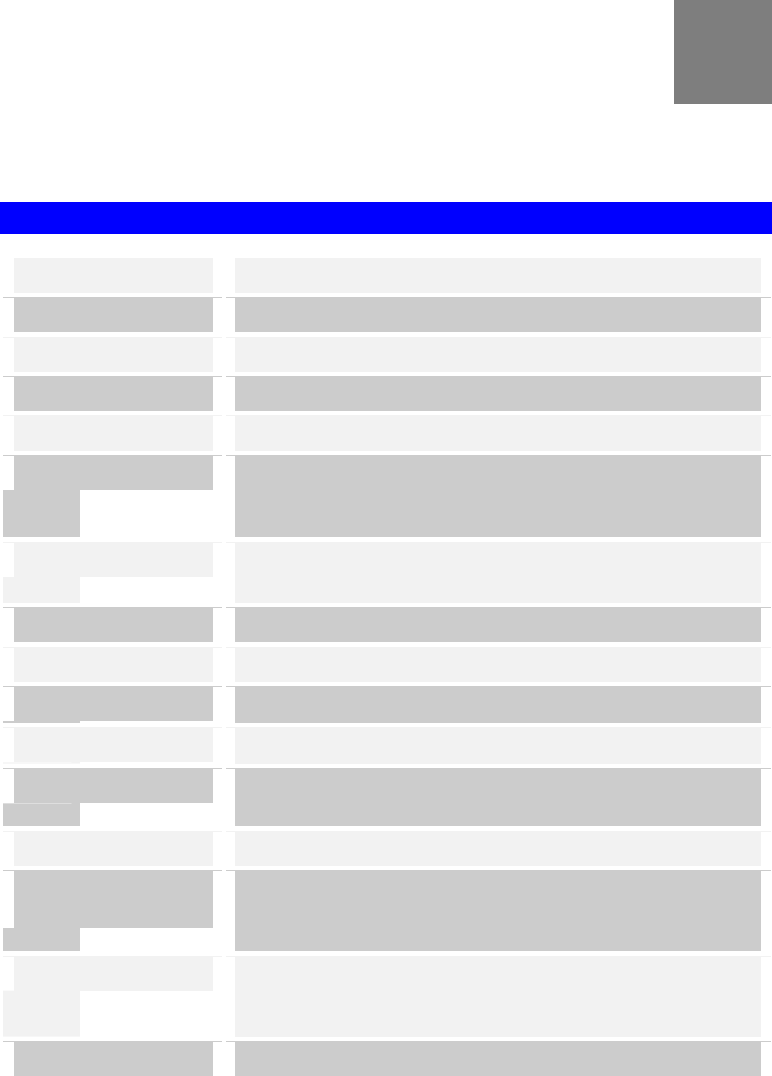
85
Appendix A
Specifications
Network Camera
Model Network Camera
Dimensions 90mm (W) * 35mm (H) * 90mm (D)
Built-in Speaker 8 ohm, 0.5W
Built-in Microphone 6mm, -40 dB+3db, >55dB
Light Sensor Min low lux trigger value: 0.5 lux
PIR Sensor Sensitivity distance: 5 meters
Angle degree: 100°(cone)
Focus distance: 6~9 meters
Pan & Tilt • Pan (320° / 4 seconds): left 160°, right 160°
• Tilt (120° / 0.8 second); up 90°, down 30°
Image Sensor Omni Vision OV7725 1/4 CMOS Sensor,
Lens F4.6mm @F1.89 Fixed Focus lens (board lens, 2P2G)
Operating Temperature 0° C to 40° C
Storage Temperature 0° C to 40° C
Network Protocols TCP/IP, DHCP, SMTP, NTP, HTTP, FTP, RTP, RTSP, UPnP
(Discovery/Traversal)
Network Interface 1 Ethernet 10/100BaseT (RJ45) LAN connection
Wireless interface
(Wireless Model Only) IEEE 802.11b/802.11g compatible, Infrastructure/Ad-hoc mode,
WEP/WPA Personal/WPA2 Personal security support, roaming
support
LEDs Ready (green)
Active (green)
Network (green)
Power Adapter 5V/2A DC External
A

86
Regulatory Approvals
CE Approvals
The Network Camera and the Ethernet Network Camera meet the guidelines of the European
Union and comply with the 99/5/EEC and RTTE 99/5EG directives, including the following
standards:
• EN60950
• EN300 328-2
• EN301 489-1
• EN301 489-17
This is a Class B product. In a domestic environment this product may cause radio interference
in which case the user may be required to take adequate measures.
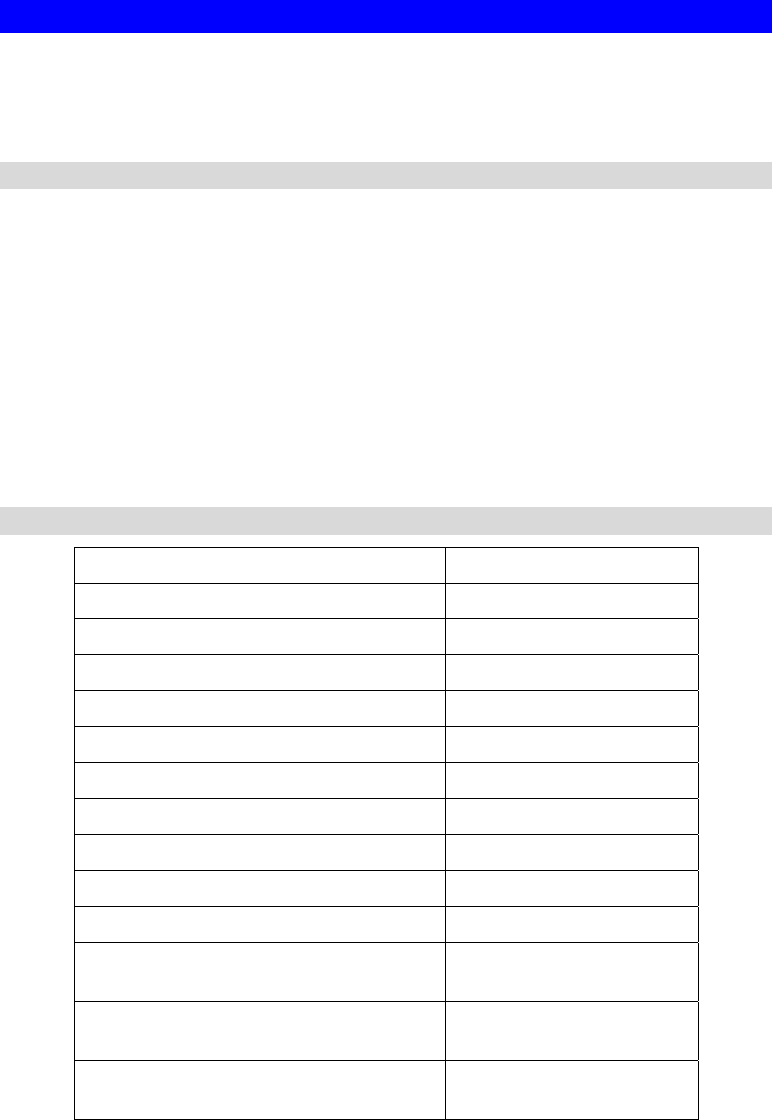
87
Copyright Notice
Many software components are covered by the GNU GPL (General Public License). Some are
covered by other Licenses as listed in the table below.
Details of each applicable license are contained in the following section.
No Warranty
THIS SOFTWARE IS PROVIDED BY THE AUTHOR AND CONTRIBUTORS ``AS IS''
AND ANY EXPRESS OR IMPLIED WARRANTIES, INCLUDING, BUT NOT LIMITED
TO, THE IMPLIED WARRANTIES OF MERCHANTABILITY AND FITNESS FOR A
PARTICULAR PURPOSE ARE DISCLAIMED. IN NO EVENT SHALL THE AUTHOR
OR CONTRIBUTORS BE LIABLE FOR ANY DIRECT, INDIRECT, INCIDENTAL,
SPECIAL, EXEMPLARY, OR CONSEQUENTIAL DAMAGES (INCLUDING, BUT NOT
LIMITED TO, PROCUREMENT OF SUBSTITUTE GOODS OR SERVICES; LOSS OF
USE, DATA, OR PROFITS; OR BUSINESS INTERRUPTION) HOWEVER CAUSED AND
ON ANY THEORY OF LIABILITY, WHETHER IN CONTRACT, STRICT LIABILITY, OR
TORT (INCLUDING NEGLIGENCE OR OTHERWISE) ARISING IN ANY WAY OUT OF
THE USE OF THIS SOFTWARE, EVEN IF ADVISED OF THE POSSIBILITY OF SUCH
DAMAGE.
Network Camera copyright information
Package source codes License
bootloader GPL
arm-linux 2.6.5 GPL
arm-linux-gcc 3.4.1 library LGPL
DM9000 lan driver GPL
Busy-box GPL
boa-0.94.13a GPL
ez-ipupdate GPL
dhcpd-1.3.22 GPL
boa-0.94-13e11 GPL
WPA_supplicant GPL
cron Public domain (BSD & Lineo
http://www.lineo.com/)
ntp-4.1.71 Public domain
(http://www.ntp.org/)
libupnp-1.2.1 Intel
(http://upnp.sourceforge.net/)
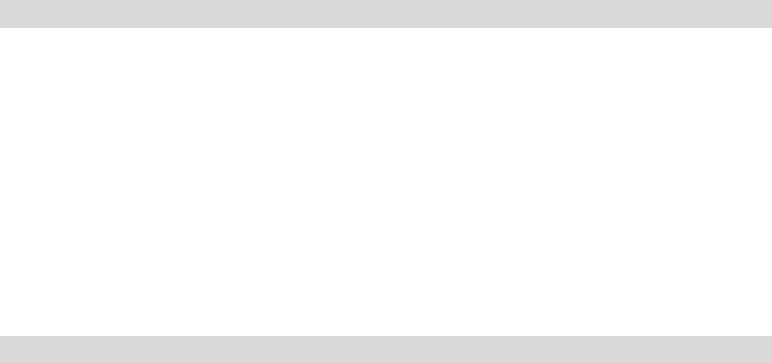
88
ntp-4.1.71 license
Copyright (c) David L. Mills 1992-2001
Permission to use, copy, modify, and distribute this software and its documentation for any
purpose and without fee is hereby granted, provided that the above copyright notice appears in
all copies and that both the copyright notice and this permission notice appear in supporting
documentation, and that the name University of Delaware not be used in advertising or
publicity pertaining to distribution of the software without specific, written prior permission.
The University of Delaware makes no representations about the suitability this software for any
purpose. It is provided "as is" without express or implied warranty.
Libupnp-1.2.1 License
Copyright (c) 2000 Intel Corporation. All rights reserved.
Redistribution and use in source and binary forms, with or without modification, are permitted
provided that the following conditions are met:
1. Redistributions of source code must retain the above copyright notice, this list of conditions
and the following disclaimer.
2. Redistributions in binary form must reproduce the above copyright notice, this list of
conditions and the following disclaimer in the documentation and/or other materials provided
with the distribution.
3. Neither name of Intel Corporation nor the names of its contributors may be used to endorse
or promote products derived from this software without specific prior written permission.
THIS SOFTWARE IS PROVIDED BY THE COPYRIGHT HOLDERS AND
CONTRIBUTORS "AS IS" AND ANY EXPRESS OR IMPLIED WARRANTIES,
INCLUDING, BUT NOT LIMITED TO, THE IMPLIED WARRANTIES OF
MERCHANTABILITY AND FITNESS FOR A PARTICULAR PURPOSE ARE
DISCLAIMED. IN NO EVENT SHALL INTEL OR CONTRIBUTORS BE LIABLE FOR
ANY DIRECT, INDIRECT, INCIDENTAL, SPECIAL, EXEMPLARY, OR
CONSEQUENTIAL DAMAGES (INCLUDING, BUT NOT LIMITED TO PROCUREMENT
OF SUBSTITUTE GOODS OR SERVICES; LOSS OF USE, DATA, OR PROFITS; OR
BUSINESS INTERRUPTION) HOWEVER CAUSED AND ON ANY THEORY OF
LIABILITY, WHETHER IN CONTRACT, STRICT LIABILITY, OR TORT (INCLUDING
NEGLIGENCE OR OTHERWISE) ARISING IN ANY WAY OUT OF THE USE OF THIS
SOFTWARE, EVEN IF ADVISED OF THE POSSIBILITY OF SUCH DAMAGE.

89
cron license
Copyright (c) 1989 The Regents of the University of California. All rights reserved.
This code is derived from software contributed to Berkeley by Paul Vixie.
Redistribution and use in source and binary forms are permitted provided that the above
copyright notice and this paragraph are duplicated in all such forms and that any
documentation, advertising materials, and other materials related to such distribution and use
acknowledge that the software was developed by the University of California, Berkeley. The
name of the University may not be used to endorse or promote products derived from this
software without specific prior written permission.
THIS SOFTWARE IS PROVIDED ''AS IS'' AND WITHOUT ANY EXPRESS OR IMPLIED
WARRANTIES, INCLUDING, WITHOUT LIMITATION, THE IMPLIED WARRANTIES
OF MERCHANTABILITY AND FITNESS FOR A PARTICULAR PURPOSE.

90
GNU General Public License
GNU GENERAL PUBLIC LICENSE
Version 2, June 1991
Copyright (C) 1989, 1991 Free Software Foundation, Inc.
51 Franklin St, Fifth Floor, Boston, MA 02110-1301 USA
Everyone is permitted to copy and distribute verbatim copies of this license document, but
changing it is not allowed.
Preamble
The licenses for most software are designed to take away your freedom to share and change it.
By contrast, the GNU General Public License is intended to guarantee your freedom to share
and change free software--to make sure the software is free for all its users. This General
Public License applies to most of the Free Software Foundation's software and to any other
program whose authors commit to using it. (Some other Free Software Foundation software is
covered by the GNU Library General Public License instead.) You can apply it to your
programs, too.
When we speak of free software, we are referring to freedom, not price. Our General Public
Licenses are designed to make sure that you have the freedom to distribute copies of free
software (and charge for this service if you wish), that you receive source code or can get itif
you want it, that you can change the software or use pieces of it in new free programs; and that
you know you can do these things.
To protect your rights, we need to make restrictions that forbid anyone to deny you these rights
or to ask you to surrender the rights. These restrictions translate to certain responsibilities for
you if you distribute copies of the software, or if you modify it.
For example, if you distribute copies of such a program, whether gratis or for a fee, you must
give the recipients all the rights that you have. You must make sure that they, too, receive or
can get the source code. And you must show them these terms so they know their rights.
We protect your rights with two steps: (1) copyright the software, and (2) offer you this license
which gives you legal permission to copy, distribute and/or modify the software.
Also, for each author's protection and ours, we want to make certain that everyone understands
that there is no warranty for this free software. If the software is modified by someone else and
passed on, we want its recipients to know that what they have is not the original, so that any
problems introduced by others will not reflect on the original authors' reputations.
Finally, any free program is threatened constantly by software patents. We wish to avoid the
danger that redistributors of a free program will individually obtain patent licenses, in effect
making the program proprietary. To prevent this, we have made it clear that any patent must
be licensed for everyone's free use or not licensed at all.
The precise terms and conditions for copying, distribution and modification follow.
GNU GENERAL PUBLIC LICENSE
Terms And Conditions For Copying, Distribution And Modification
0. This License applies to any program or other work which contains a notice placed by the
copyright holder saying it may be distributed under the terms of this General Public License.
The "Program", below, refers to any such program or work, and a "work based on the
Program" means either the Program or any derivative work under copyright law: that is to say,
a work containing the Program or a portion of it, either verbatim or with modifications and/or
91
translated into another language. (Hereinafter, translation is included without limitation in the
term "modification".) Each licensee is addressed as "you".
Activities other than copying, distribution and modification are not covered by this License;
they are outside its scope. The act of running the Program is not restricted, and the output from
the Program is covered only if its contents constitute a work based on the Program
(independent of having been made by running the Program). Whether that is true depends on
what the Program does.
1. You may copy and distribute verbatim copies of the Program's source code as you receive it,
in any medium, provided that you conspicuously and appropriately publish on each copy an
appropriate copyright notice and disclaimer of warranty; keep intact all the notices that refer to
this License and to the absence of any warranty; and give any other recipients of the Program a
copy of this License along with the Program.
You may charge a fee for the physical act of transferring a copy, and you may at your option
offer warranty protection in exchange for a fee.
2. You may modify your copy or copies of the Program or any portion of it, thus forming a
work based on the Program, and copy and distribute such modifications or work under the
terms of Section 1 above, provided that you also meet all of these conditions:
a) You must cause the modified files to carry prominent notices stating that you changed the
files and the date of any change.
b) You must cause any work that you distribute or publish, that in whole or in part contains or
is derived from the Program or any part thereof, to be licensed as a whole at no charge to all
third parties under the terms of this License.
c) If the modified program normally reads commands interactively when run, you must cause
it, when started running for such interactive use in the most ordinary way, to print or display an
announcement including an appropriate copyright notice and a notice that there is no warranty
(or else, saying that you provide a warranty) and that users may redistribute the program under
these conditions, and telling the user how to view a copy of this License. (Exception: if the
Program itself is interactive but does not normally print such an announcement, your work
based on the Program is not required to print an announcement.)
These requirements apply to the modified work as a whole. If identifiable sections of that
work are not derived from the Program, and can be reasonably considered independent and
separate works in themselves, then this License, and its terms, do not apply to those sections
when you distribute them as separate works. But when you distribute the same sections as part
of a whole which is a work based on the Program, the distribution of the whole must be on the
terms of this License, whose permissions for other licensees extend to the entire whole, and
thus to each and every part regardless of who wrote it.
Thus, it is not the intent of this section to claim rights or contest your rights to work written
entirely by you; rather, the intent is to exercise the right to control the distribution of derivative
or collective works based on the Program.
In addition, mere aggregation of another work not based on the Program with the Program (or
with a work based on the Program) on a volume of a storage or distribution medium does not
bring the other work under the scope of this License.
3. You may copy and distribute the Program (or a work based on it, under Section 2) in object
code or executable form under the terms of Sections 1 and 2 above provided that you also do
one of the following:
a) Accompany it with the complete corresponding machine-readable source code, which must
be distributed under the terms of Sections 1 and 2 above on a medium customarily used for
software interchange; or,
92
b) Accompany it with a written offer, valid for at least three years, to give any third party, for a
charge no more than your cost of physically performing source distribution, a complete
machine-readable copy of the corresponding source code, to be distributed under the terms of
Sections 1 and 2 above on a medium customarily used for software interchange; or,
c) Accompany it with the information you received as to the offer to distribute corresponding
source code. (This alternative is allowed only for noncommercial distribution and only if you
received the program in object code or executable form with such an offer, in accord with
Subsection b above.)
The source code for a work means the preferred form of the work for making modifications to
it. For an executable work, complete source code means all the source code for all modules it
contains, plus any associated interface definition files, plus the scripts used to control
compilation and installation of the executable. However, as a special exception, the source
code distributed need not include anything that is normally distributed (in either source or
binary form) with the major components (compiler, kernel, and so on) of the operating system
on which the executable runs, unless that component itself accompanies the executable.
If distribution of executable or object code is made by offering access to copy from a
designated place, then offering equivalent access to copy the source code from the same place
counts as distribution of the source code, even though third parties are not compelled to copy
the source along with the object code.
4. You may not copy, modify, sublicense, or distribute the Program except as expressly
provided under this License. Any attempt otherwise to copy, modify, sublicense or distribute
the Program is void, and will automatically terminate your rights under this License. However,
parties who have received copies, or rights, from you under this License will not have their
licenses terminated so long as such parties remain in full compliance.
5. You are not required to accept this License, since you have not signed it. However, nothing
else grants you permission to modify or distribute the Program or its derivative works. These
actions are prohibited by law if you do not accept this License. Therefore, by modifying or
distributing the Program (or any work based on the Program), you indicate your acceptance of
this License to do so, and all its terms and conditions for copying, distributing or modifying the
Program or works based on it.
6. Each time you redistribute the Program (or any work based on the Program), the recipient
automatically receives a license from the original licensor to copy, distribute or modify the
Program subject to these terms and conditions. You may not impose any further restrictions on
the recipients' exercise of the rights granted herein.You are not responsible for enforcing
compliance by third parties to this License.
7. If, as a consequence of a court judgment or allegation of patent infringement or for any other
reason (not limited to patent issues), conditions are imposed on you (whether by court order,
agreement or otherwise) that contradict the conditions of this License, they do not excuse you
from the conditions of this License. If you cannot distribute so as to satisfy simultaneously
your obligations under this License and any other pertinent obligations, then as a consequence
you may not distribute the Program at all. For example, if a patent license would not permit
royalty-free redistribution of the Program by all those who receive copies directly or indirectly
through you, then the only way you could satisfy both it and this License would be to refrain
entirely from distribution of the Program.
If any portion of this section is held invalid or unenforceable under any particular circumstance,
the balance of the section is intended to apply and the section as a whole is intended to apply in
other circumstances.
It is not the purpose of this section to induce you to infringe any patents or other property right
claims or to contest validity of any such claims; this section has the sole purpose of protecting
the integrity of the free software distribution system, which is implemented by public license
93
practices. Many people have made generous contributions to the wide range of software
distributed through that system in reliance on consistent application of that system; it is up to
the author/donor to decide if he or she is willing to distribute software through any other
system and a licensee cannot impose that choice.
This section is intended to make thoroughly clear what is believed to be a consequence of the
rest of this License.
8. If the distribution and/or use of the Program is restricted in certain countries either by
patents or by copyrighted interfaces, the original copyright holder who places the Program
under this License may add an explicit geographical distribution limitation excluding those
countries, so that distribution is permitted only in or among countries not thus excluded. In
such case, this License incorporates the limitation as if written in the body of this License.
9. The Free Software Foundation may publish revised and/or new versions of the General
Public License from time to time. Such new versions will be similar in spirit to the present
version, but may differ in detail to address new problems or concerns.
Each version is given a distinguishing version number. If the Program specifies a version
number of this License which applies to it and "any later version", you have the option of
following the terms and conditions either of that version or of any later version published by
the Free Software Foundation. If the Program does not specify a version number of this
License, you may choose any version ever published by the Free Software Foundation.
10. If you wish to incorporate parts of the Program into other free programs whose distribution
conditions are different, write to the author to ask for permission. For software which is
copyrighted by the Free Software Foundation, write to the Free Software Foundation; we
sometimes make exceptions for this. Our decision will be guided by the two goals of
preserving the free status of all derivatives of our free software and of promoting the sharing
and reuse of software generally.
NO WARRANTY
11. BECAUSE THE PROGRAM IS LICENSED FREE OF CHARGE, THERE IS NO
WARRANTY FOR THE PROGRAM, TO THE EXTENT PERMITTED BY APPLICABLE
LAW. EXCEPT WHEN OTHERWISE STATED IN WRITING THE COPYRIGHT
HOLDERS AND/OR OTHER PARTIES PROVIDE THE PROGRAM "AS IS" WITHOUT
WARRANTY OF ANY KIND, EITHER EXPRESSED OR IMPLIED, INCLUDING, BUT
NOT LIMITED TO, THE IMPLIED WARRANTIES OF MERCHANTABILITY AND
FITNESS FOR A PARTICULAR PURPOSE. THE ENTIRE RISK AS TO THE QUALITY
AND PERFORMANCE OF THE PROGRAM IS WITH YOU. SHOULD THE PROGRAM
PROVE DEFECTIVE, YOU ASSUME THE COST OF ALL NECESSARY SERVICING,
REPAIR OR CORRECTION.
12. IN NO EVENT UNLESS REQUIRED BY APPLICABLE LAW OR AGREED TO IN
WRITING WILL ANY COPYRIGHT HOLDER, OR ANY OTHER PARTY WHO MAY
MODIFY AND/OR REDISTRIBUTE THE PROGRAM AS PERMITTED ABOVE, BE
LIABLE TO YOU FOR DAMAGES, INCLUDING ANY GENERAL, SPECIAL,
INCIDENTAL OR CONSEQUENTIAL DAMAGES ARISING OUT OF THE USE OR
INABILITY TO USE THE PROGRAM (INCLUDING BUT NOT LIMITED TO LOSS OF
DATA OR DATA BEING RENDERED INACCURATE OR LOSSES SUSTAINED BY
YOU OR THIRD PARTIES OR A FAILURE OF THE PROGRAM TO OPERATE WITH
ANY OTHER PROGRAMS), EVEN IF SUCH HOLDER OR OTHER PARTY HAS BEEN
ADVISED OF THE POSSIBILITY OF SUCH DAMAGES.

94
END OF TERMS AND CONDITIONS
This equipment has been tested and found to comply with the limits for a Class B digital device, pursuant to part 15 of the FCC
rules. These limits are designed to provide reasonable protection against harmful interference in a residential installation. This
equipment generates, uses and can radiate radio frequency energy and, if not installed and used in accordance with the
instructions, may cause harmful interference to radio communications. However, there is no guarantee that interference will not
occur in a particular installation. If this equipment does cause harmful interference to radio or television reception, which can be
determined by turning the equipment off and on, the user is encouraged to try to correct the interference by one or more of the
following measures:
-Reorient or relocate the receiving antenna.
-Increase the separation between the equipment and receiver.
-Connect the equipment into an outlet on a circuit different from that to which the receiver is connected.
-Consult the dealer or an experienced radio/TV technician for help.
You are cautioned that changes or modifications not expressly approved by the party responsible for compliance could void your
authority to operate the equipment.
This device complies with Part 15 of the FCC Rules. Operation is subject to the following two conditions: (1) this device may
not cause harmful interference and (2) this device must accept any interference received, including interference that may cause
operation
This device complies with Part 15 of the FCC Rules. Operation is subject to the following two conditions: (1) this device may
not cause harmful interference and (2) this device must accept any interference received, including interference that may cause
undesired operation
This device complies with Part 15 of the FCC Rules. Operation is subject to the following two conditions: (1) this device may
not cause harmful interference and (2) this device must accept any interference received, including interference that may cause
undesired operation
FCC RF Radiation Exposure Statement:
1. This Transmitter must not be co-located or operating in conjunction with any other antenna or transmitter.
2. This equipment complies with FCC RF radiation exposure limits set forth for an uncontrolled environment. This equipment
should be installed and operated with a minimum distance of 20 centimeters between the radiator and your body.
REMARK
IEEE 802.11b or 802.11g operation of this product in the U.S.A. is firmware-limited to channels 1 through 11.

95
Lesser GNU General Public License
GNU LESSER GENERAL PUBLIC LICENSE
Version 2.1, February 1999
Copyright (C) 1991, 1999 Free Software Foundation, Inc.
51 Franklin St, Fifth Floor, Boston, MA 02110-1301 USA
Everyone is permitted to copy and distribute verbatim copies of this license document, but
changing it is not allowed.
[This is the first released version of the Lesser GPL. It also counts as the successor of the
GNU Library Public License, version 2, hence the version number 2.1.]
Preamble
The licenses for most software are designed to take away your freedom to share and change it.
By contrast, the GNU General Public Licenses are intended to guarantee your freedom to share
and change free software--to make sure the software is free for all its users.
This license, the Lesser General Public License, applies to some specially designated software
packages--typically libraries--of the Free Software Foundation and other authors who decide to
use it. You can use it too, but we suggest you first think carefully about whether this license or
the ordinary General Public License is the better strategy to use in any particular case, based on
the explanations below.
When we speak of free software, we are referring to freedom of use, not price. Our General
Public Licenses are designed to make sure that you have the freedom to distribute copies of
free software (and charge for this service if you wish); that you receive source code or can get
it if you want it; that you can change the software and use pieces of it in new free programs;
and that you are informed that you can do these things.
To protect your rights, we need to make restrictions that forbid distributors to deny you these
rights or to ask you to surrender these rights. These restrictions translate to certain
responsibilities for you if you distribute copies of the library or if you modify it.
For example, if you distribute copies of the library, whether gratis or for a fee, you must give
the recipients all the rights that we gave you. You must make sure that they, too, receive or
can get the source code. If you link other code with the library, you must provide complete
object files to the recipients, so that they can relink them with the library after making changes
to the library and recompiling it. And you must show them these terms so they know their
rights.
We protect your rights with a two-step method: (1) we copyright the library, and (2) we offer
you this license, which gives you legal permission to copy, distribute and/or modify the library.
To protect each distributor, we want to make it very clear that there is no warranty for the free
library. Also, if the library is modified by someone else and passed on, the recipients should
know that what they have is not the original version, so that the original author's reputation will
not be affected by problems that might be introduced by others.
96
Finally, software patents pose a constant threat to the existence of any free program. We wish
to make sure that a company cannot effectively restrict the users of a free program by obtaining
a restrictive license from a patent holder. Therefore, we insist that any patent license obtained
for a version of the library must be consistent with the full freedom of use specified in this
license.
Most GNU software, including some libraries, is covered by the ordinary GNU General Public
License. This license, the GNU Lesser General Public License, applies to certain designated
libraries, and is quite different from the ordinary General Public License. We use this license
for certain libraries in order to permit linking those libraries into non-free programs.
When a program is linked with a library, whether statically or using a shared library, the
combination of the two is legally speaking a combined work, a derivative of the original library.
The ordinary General Public License therefore permits such linking only if the entire
combination fits its criteria of freedom. The Lesser General Public License permits more lax
criteria for linking other code with the library.
We call this license the "Lesser" General Public License because it does Less to protect the
user's freedom than the ordinary General Public License. It also provides other free software
developers Less of an advantage over competing non-free programs. These disadvantages are
the reason we use the ordinary General Public License for many libraries. However, the Lesser
license provides advantages in certain special circumstances.
For example, on rare occasions, there may be a special need to encourage the widest possible
use of a certain library, so that it becomes a de-facto standard. To achieve this, non-free
programs must be allowed to use the library. A more frequent case is that a free library does
the same job as widely used non-free libraries. In this case, there is little to gain by limiting the
free library to free software only, so we use the Lesser General Public License.
In other cases, permission to use a particular library in non-free programs enables a greater
number of people to use a large body of free software. For example, permission to use the
GNU C Library in non-free programs enables many more people to use the whole GNU
operating system, as well as its variant, the GNU/Linux operating system.
Although the Lesser General Public License is Less protective of the users' freedom, it does
ensure that the user of a program that is linked with the Library has the freedom and the
wherewithal to run that program using a modified version of the Library.
The precise terms and conditions for copying, distribution and modification follow. Pay close
attention to the difference between a "work based on the library" and a "work that uses the
library". The former contains code derived from the library, whereas the latter must be
combined with the library in order to run.
GNU LESSER GENERAL PUBLIC LICENSE
TERMS AND CONDITIONS FOR COPYING, DISTRIBUTION AND
MODIFICATION
0. This License Agreement applies to any software library or other program which contains a
notice placed by the copyright holder or other authorized party saying it may be distributed
under the terms of this Lesser General Public License (also called "this License"). Each
licensee is addressed as "you".
A "library" means a collection of software functions and/or data prepared so as to be
conveniently linked with application programs (which use some of those functions and data) to
form executables.
97
The "Library", below, refers to any such software library or work which has been distributed
under these terms. A "work based on the Library" means either the Library or any derivative
work under copyright law: that is to say, a work containing the Library or a portion of it, either
verbatim or with modifications and/or translated straightforwardly into another language.
(Hereinafter, translation is included without limitation in the term "modification".)
"Source code" for a work means the preferred form of the work for making modifications to it.
For a library, complete source code means all the source code for all modules it contains, plus
any associated interface definition files, plus the scripts used to control compilation and
installation of the library.
Activities other than copying, distribution and modification are not covered by this License;
they are outside its scope. The act of running a program using the Library is not restricted, and
output from such a program is covered only if its contents constitute a work based on the
Library (independent of the use of the Library in a tool for writing it). Whether that is true
depends on what the Library does and what the program that uses the Library does.
1. You may copy and distribute verbatim copies of the Library's complete source code as you
receive it, in any medium, provided that you conspicuously and appropriately publish on each
copy an appropriate copyright notice and disclaimer of warranty; keep intact all the notices that
refer to this License and to the absence of any warranty; and distribute a copy of this License
along with the Library.
You may charge a fee for the physical act of transferring a copy, and you may at your option
offer warranty protection in exchange for a fee.
2. You may modify your copy or copies of the Library or any portion of it, thus forming a work
based on the Library, and copy and distribute such modifications or work under the terms of
Section 1 above, provided that you also meet all of these conditions:
a) The modified work must itself be a software library.
b) You must cause the files modified to carry prominent notices stating that you changed the
files and the date of any change.
c) You must cause the whole of the work to be licensed at no charge to all third parties under
the terms of this License.
d) If a facility in the modified Library refers to a function or a table of data to be supplied by an
application program that uses the facility, other than as an argument passed when the facility is
invoked, then you must make a good faith effort to ensure that, in the event an application does
not supply such function or table, the facility still operates, and performs whatever part of its
purpose remains meaningful.
(For example, a function in a library to compute square roots has a purpose that is entirely
well-defined independent of the application. Therefore, Subsection 2d requires that any
application-supplied function or table used by this function must be optional: if the application
does not supply it, the square root function must still compute square roots.)
These requirements apply to the modified work as a whole. If identifiable sections of that
work are not derived from the Library, and can be reasonably considered independent and
separate works in themselves, then this License, and its terms, do not apply to those sections
when you distribute them as separate works. But when you distribute the same sections as part
of a whole which is a work based on the Library, the distribution of the whole must be on the
terms of this License, whose permissions for other licensees extend to the entire whole, and
thus to each and every part regardless of who wrote it.
Thus, it is not the intent of this section to claim rights or contest your rights to work written
entirely by you; rather, the intent is to exercise the right to control the distribution of derivative
or collective works based on the Library.
98
In addition, mere aggregation of another work not based on the Library with the Library (or
with a work based on the Library) on a volume of a storage or distribution medium does not
bring the other work under the scope of this License.
3. You may opt to apply the terms of the ordinary GNU General Public License instead of this
License to a given copy of the Library. To do this, you must alter all the notices that refer to
this License, so that they refer to the ordinary GNU General Public License, version 2, instead
of to this License. (If a newer version than version 2 of the ordinary GNU General Public
License has appeared, then you can specify that version instead if you wish.) Do not make any
other change in these notices.
Once this change is made in a given copy, it is irreversible for that copy, so the ordinary GNU
General Public License applies to all subsequent copies and derivative works made from that
copy.
This option is useful when you wish to copy part of the code of the Library into a program that
is not a library.
4. You may copy and distribute the Library (or a portion or derivative of it, under Section 2) in
object code or executable form under the terms of Sections 1 and 2 above provided that you
accompany it with the complete corresponding machine-readable source code, which must be
distributed under the terms of Sections 1 and 2 above on a medium customarily used for
software interchange.
If distribution of object code is made by offering access to copy from a designated place, then
offering equivalent access to copy the source code from the same place satisfies the
requirement to distribute the source code, even though third parties are not compelled to copy
the source along with the object code.
5. A program that contains no derivative of any portion of the Library, but is designed to work
with the Library by being compiled or linked with it, is called a "work that uses the Library".
Such a work, in isolation, is not a derivative work of the Library, and therefore falls outside the
scope of this License.
However, linking a "work that uses the Library" with the Library creates an executable that is a
derivative of the Library (because it contains portions of the Library), rather than a "work that
uses the library". The executable is therefore covered by this License.
Section 6 states terms for distribution of such executables.
When a "work that uses the Library" uses material from a header file that is part of the Library,
the object code for the work may be a derivative work of the Library even though the source
code is not. Whether this is true is especially significant if the work can be linked without the
Library, or if the work is itself a library. The threshold for this to be true is not precisely
defined by law.
If such an object file uses only numerical parameters, data structure layouts and accessors, and
small macros and small inline functions (ten lines or less in length), then the use of the object
file is unrestricted, regardless of whether it is legally a derivative work. (Executables
containing this object code plus portions of the Library will still fall under Section 6.)
Otherwise, if the work is a derivative of the Library, you may distribute the object code for the
work under the terms of Section 6. Any executables containing that work also fall under
Section 6, whether or not they are linked directly with the Library itself.
99
6. As an exception to the Sections above, you may also combine or link a "work that uses the
Library" with the Library to produce a work containing portions of the Library, and distribute
that work under terms of your choice, provided that the terms permit modification of the work
for the customer's own use and reverse engineering for debugging such modifications.
You must give prominent notice with each copy of the work that the Library is used in it and
that the Library and its use are covered by this License. You must supply a copy of this
License. If the work during execution displays copyright notices, you must include the
copyright notice for the Library among them, as well as a reference directing the user to the
copy of this License. Also, you must do one of these things:
a) Accompany the work with the complete corresponding machine-readable source code for the
Library including whatever changes were used in the work (which must be distributed under
Sections 1 and 2 above); and, if the work is an executable linked with the Library, with the
complete machine-readable "work that uses the Library", as object code and/or source code, so
that the user can modify the Library and then relink to produce a modified executable
containing the modified Library. (It is understood that the user who changes the contents of
definitions files in the Library will not necessarily be able to recompile the application to use
the modified definitions.)
b) Use a suitable shared library mechanism for linking with the Library. A suitable mechanism
is one that (1) uses at run time a copy of the library already present on the user's computer
system, rather than copying library functions into the executable, and (2) will operate properly
with a modified version of the library, if the user installs one, as long as the modified version is
interface-compatible with the version that the work was made with.
c) Accompany the work with a written offer, valid for at least three years, to give the same user
the materials specified in Subsection 6a, above, for a charge no more than the cost of
performing this distribution.
d) If distribution of the work is made by offering access to copy from a designated place, offer
equivalent access to copy the above specified materials from the same place.
e) Verify that the user has already received a copy of these materials or that you have already
sent this user a copy.
For an executable, the required form of the "work that uses the Library" must include any data
and utility programs needed for reproducing the executable from it. However, as a special
exception, the materials to be distributed need not include anything that is normally distributed
(in either source or binary form) with the major components (compiler, kernel, and so on) of
the operating system on which the executable runs, unless that component itself accompanies
the executable.
It may happen that this requirement contradicts the license restrictions of other proprietary
libraries that do not normally accompany the operating system. Such a contradiction means
you cannot use both them and the Library together in an executable that you distribute.
7. You may place library facilities that are a work based on the Library side-by-side in a single
library together with other library facilities not covered by this License, and distribute such a
combined library, provided that the separate distribution of the work based on the Library and
of the other library facilities is otherwise permitted, and provided that you do these two things:
a) Accompany the combined library with a copy of the same work based on the Library,
uncombined with any other library facilities. This must be distributed under the terms of the
Sections above.
b) Give prominent notice with the combined library of the fact that part of it is a work based on
the Library, and explaining where to find the accompanying uncombined form of the same
work.
100
8. You may not copy, modify, sublicense, link with, or distribute the Library except as
expressly provided under this License. Any attempt otherwise to copy, modify, sublicense,
link with, or distribute the Library is void, and will automatically terminate your rights under
this License. However, parties who have received copies, or rights, from you under this
License will not have their licenses terminated so long as such parties remain in full
compliance.
9. You are not required to accept this License, since you have not signed it. However, nothing
else grants you permission to modify or distribute the Library or its derivative works. These
actions are prohibited by law if you do not accept this License. Therefore, by modifying or
distributing the Library (or any work based on the Library), you indicate your acceptance of
this License to do so, and all its terms and conditions for copying, distributing or modifying the
Library or works based on it.
10. Each time you redistribute the Library (or any work based on the Library), the recipient
automatically receives a license from the original licensor to copy, distribute, link with or
modify the Library subject to these terms and conditions. You may not impose any further
restrictions on the recipients' exercise of the rights granted herein. You are not responsible for
enforcing compliance by third parties with this License.
11. If, as a consequence of a court judgment or allegation of patent infringement or for any
other reason (not limited to patent issues), conditions are imposed on you (whether by court
order, agreement or otherwise) that contradict the conditions of this License, they do not
excuse you from the conditions of this License. If you cannot distribute so as to satisfy
simultaneously your obligations under this License and any other pertinent obligations, then as
a consequence you may not distribute the Library at all. For example, if a patent license would
not permit royalty-free redistribution of the Library by all those who receive copies directly or
indirectly through you, then the only way you could satisfy both it and this License would be to
refrain entirely from distribution of the Library.
If any portion of this section is held invalid or unenforceable under any particular circumstance,
the balance of the section is intended to apply, and the section as a whole is intended to apply
in other circumstances.
It is not the purpose of this section to induce you to infringe any patents or other property right
claims or to contest validity of any such claims; this section has the sole purpose of protecting
the integrity of the free software distribution system which is implemented by public license
practices. Many people have made generous contributions to the wide range of software
distributed through that system in reliance on consistent application of that system; it is up to
the author/donor to decide if he or she is willing to distribute software through any other
system and a licensee cannot impose that choice.
This section is intended to make thoroughly clear what is believed to be a consequence of the
rest of this License.
12. If the distribution and/or use of the Library is restricted in certain countries either by
patents or by copyrighted interfaces, the original copyright holder who places the Library under
this License may add an explicit geographical distribution limitation excluding those countries,
so that distribution is permitted only in or among countries not thus excluded. In such case,
this License incorporates the limitation as if written in the body of this License.
13. The Free Software Foundation may publish revised and/or new versions of the Lesser
General Public License from time to time. Such new versions will be similar in spirit to the
present version, but may differ in detail to address new problems or concerns.
Each version is given a distinguishing version number. If the Library specifies a version
number of this License which applies to it and "any later version", you have the option of
following the terms and conditions either of that version or of any later version published by
the Free Software Foundation. If the Library does not specify a license version number, you
may choose any version ever published by the Free Software Foundation.
101
14. If you wish to incorporate parts of the Library into other free programs whose distribution
conditions are incompatible with these, write to the author to ask for permission. For software
which is copyrighted by the Free Software Foundation, write to the Free Software Foundation;
we sometimes make exceptions for this. Our decision will be guided by the two goals of
preserving the free status of all derivatives of our free software and of promoting the sharing
and reuse of software generally.
NO WARRANTY
15. BECAUSE THE LIBRARY IS LICENSED FREE OF CHARGE, THERE IS NO
WARRANTY FOR THE LIBRARY, TO THE EXTENT PERMITTED BY APPLICABLE
LAW. EXCEPT WHEN OTHERWISE STATED IN WRITING THE COPYRIGHT
HOLDERS AND/OR OTHER PARTIES PROVIDE THE LIBRARY "AS IS" WITHOUT
WARRANTY OF ANY KIND, EITHER EXPRESSED OR IMPLIED, INCLUDING, BUT
NOT LIMITED TO, THE IMPLIED WARRANTIES OF MERCHANTABILITY AND
FITNESS FOR A PARTICULAR PURPOSE. THE ENTIRE RISK AS TO THE QUALITY
AND PERFORMANCE OF THE LIBRARY IS WITH YOU. SHOULD THE LIBRARY
PROVE DEFECTIVE, YOU ASSUME THE COST OF ALL NECESSARY SERVICING,
REPAIR OR CORRECTION.
16. IN NO EVENT UNLESS REQUIRED BY APPLICABLE LAW OR AGREED TO IN
WRITING WILL ANY COPYRIGHT HOLDER, OR ANY OTHER PARTY WHO MAY
MODIFY AND/OR REDISTRIBUTE THE LIBRARY AS PERMITTED ABOVE, BE
LIABLE TO YOU FOR DAMAGES, INCLUDING ANY GENERAL, SPECIAL,
INCIDENTAL OR CONSEQUENTIAL DAMAGES ARISING OUT OF THE USE OR
INABILITY TO USE THE LIBRARY (INCLUDING BUT NOT LIMITED TO LOSS OF
DATA OR DATA BEING RENDERED INACCURATE OR LOSSES SUSTAINED BY
YOU OR THIRD PARTIES OR A FAILURE OF THE LIBRARY TO OPERATE WITH
ANY OTHER SOFTWARE), EVEN IF SUCH HOLDER OR OTHER PARTY HAS BEEN
ADVISED OF THE POSSIBILITY OF SUCH DAMAGES.
END OF TERMS AND CONDITIONS
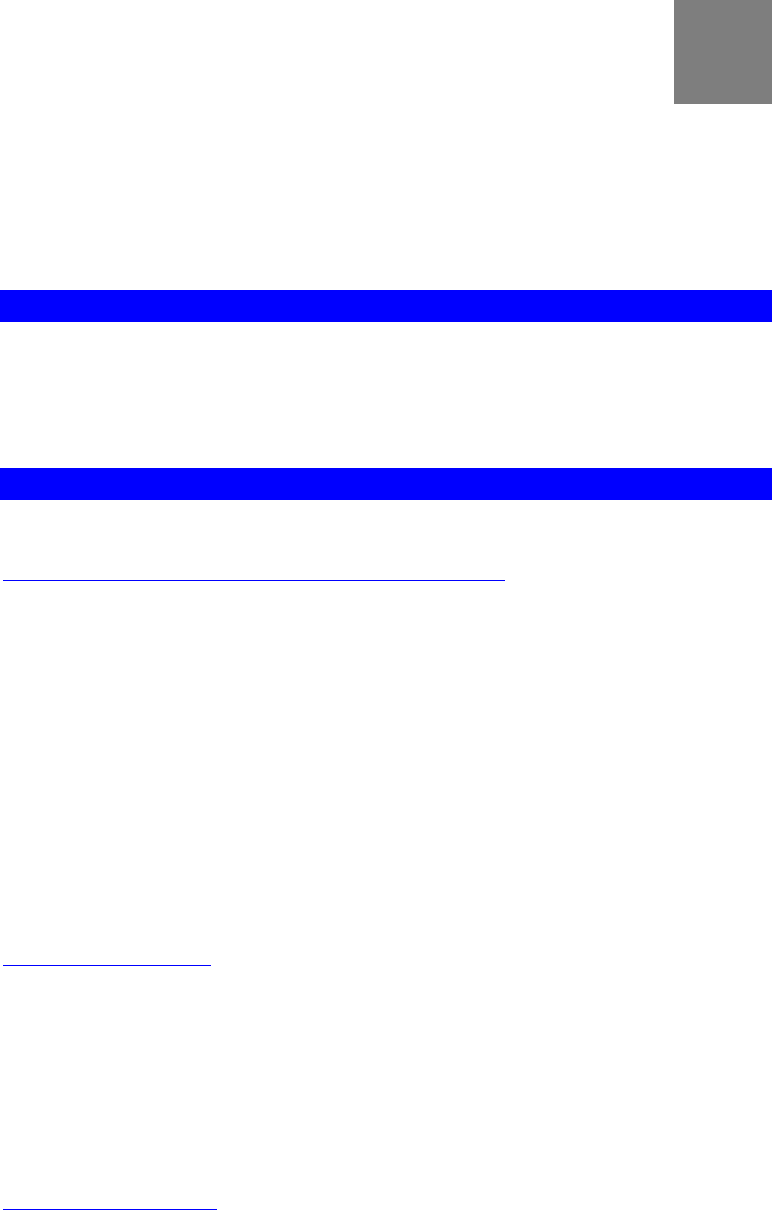
102
Appendix B
Streaming Video/Audio
Solution
Overview
Streaming video is a sequence of "moving images" that are sent in compressed form over the
Internet and displayed by the viewer as they arrive. With streaming, a Web user does not have
to wait to download a large file before seeing the video or hearing the sound. Instead, the
media is sent in a continuous stream and is played as it arrives.
Streaming Video/Audio through Internet Camera
To snapshot a JPEG image from the Internet Camera with specified resolution and quality:
http://<ip>/img/snapshot.cgi?[size=<value>][&quality=<value>]
Size = 1(160*128)
2(320*240)
3(640*480)
Quality = 1(Very high)
2(High)
3(Normal)
4(Low)
5(Very low)
To stream M-JPEG video from the Internet Camera (M-JPEG mode only)
http://<ip>/img/mjpeg.cgi or http://<ip>/img/mjpeg.htm
To stream video through the RTP/RTSP protocol from Internet Camera (MPEG-4 mode only)
rtsp://<ip>/img/media.sav
Note: Users need to specify the desired protocol in the players.
To snapshot a JPEG image (160*128, very low quality) through a mobile phone:
http://<ip>/img/mobile.cgi
B